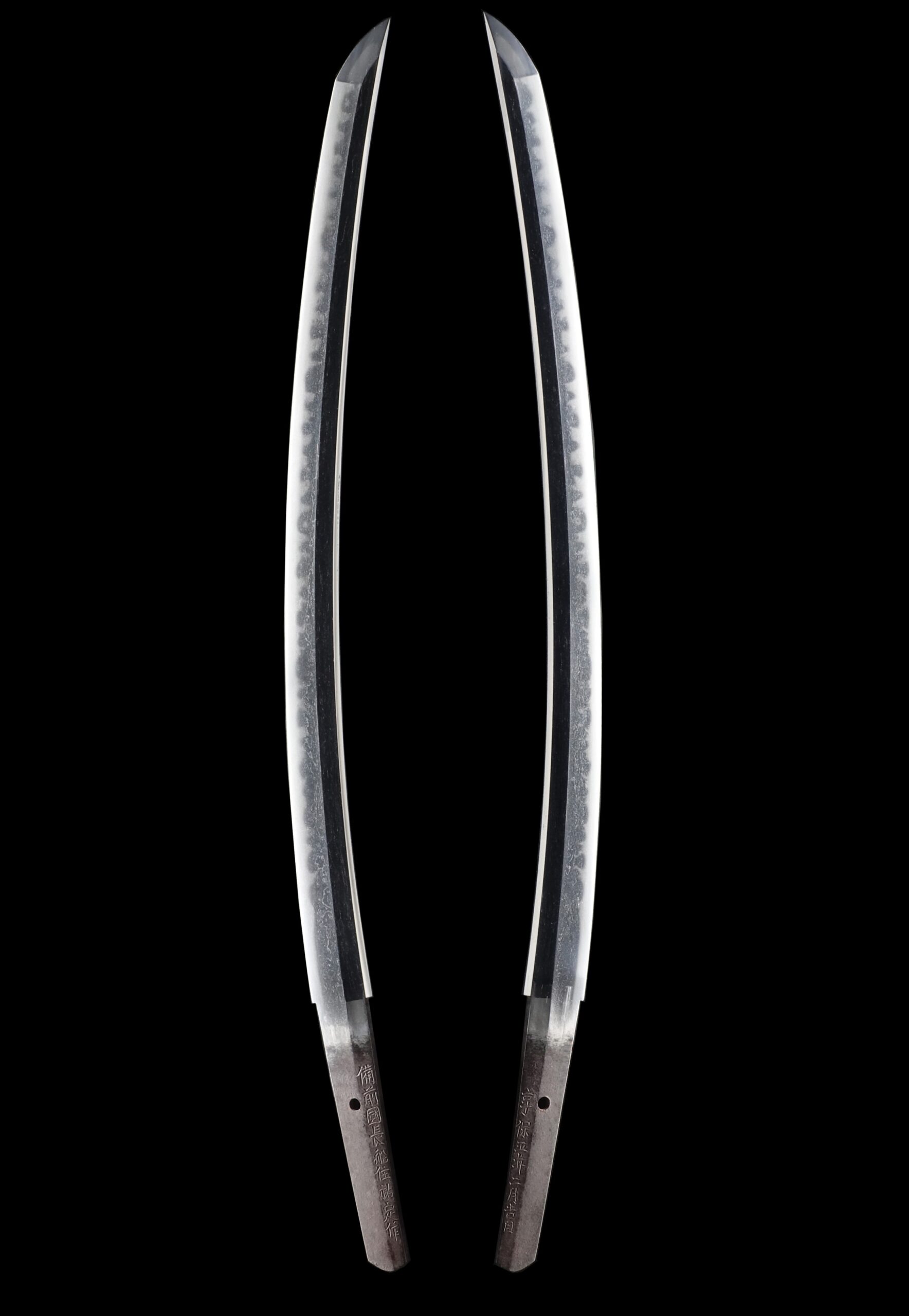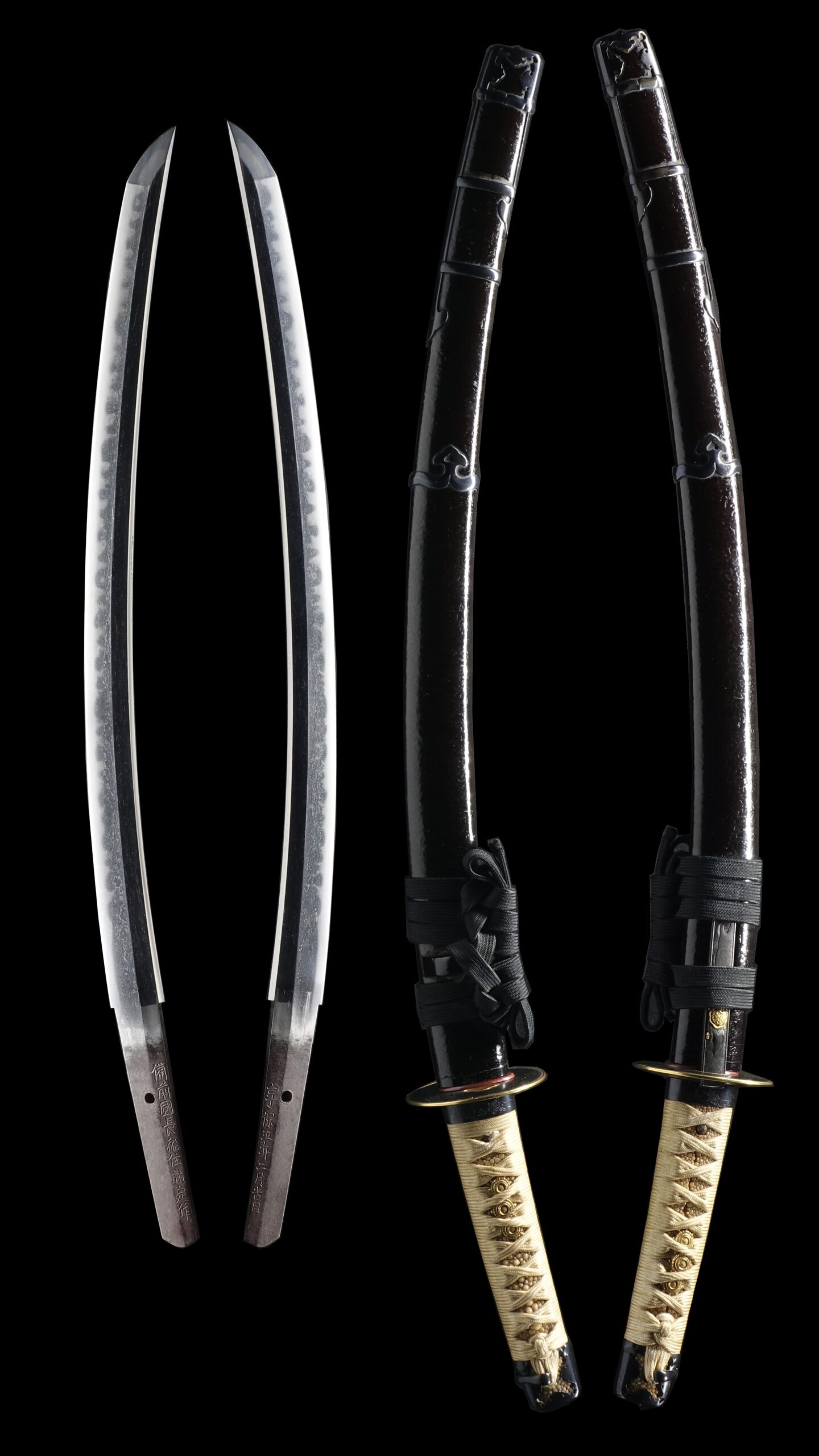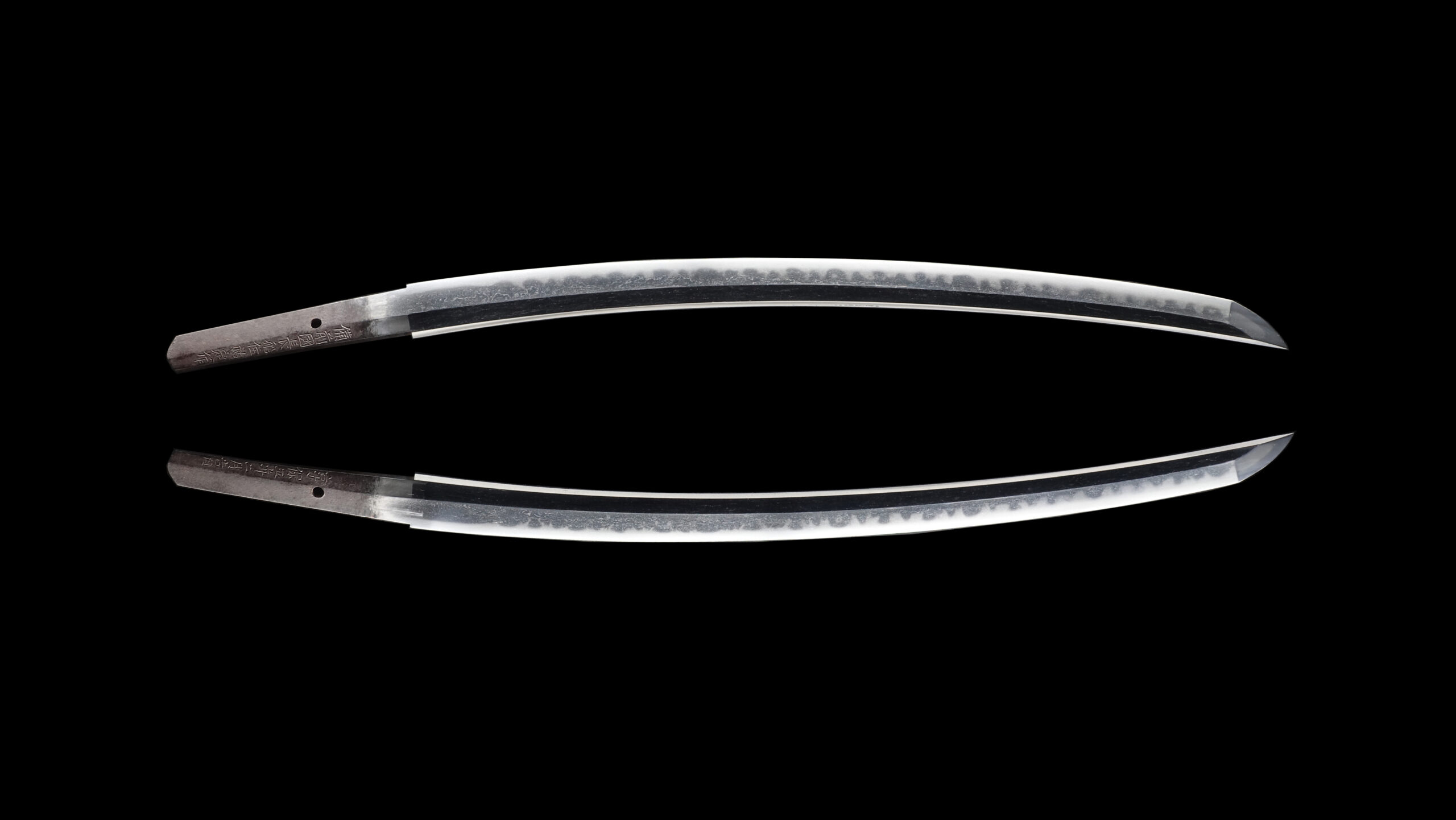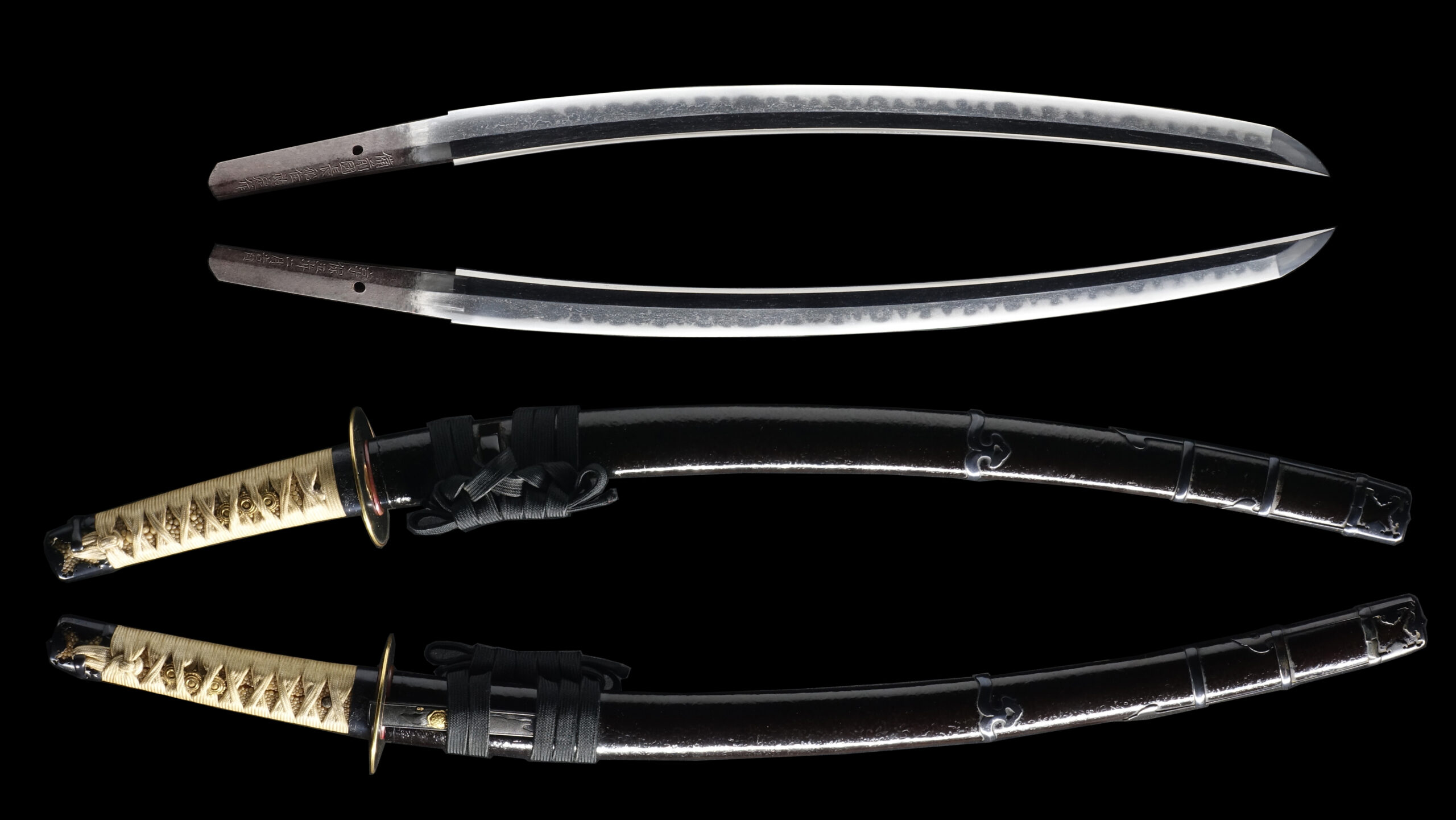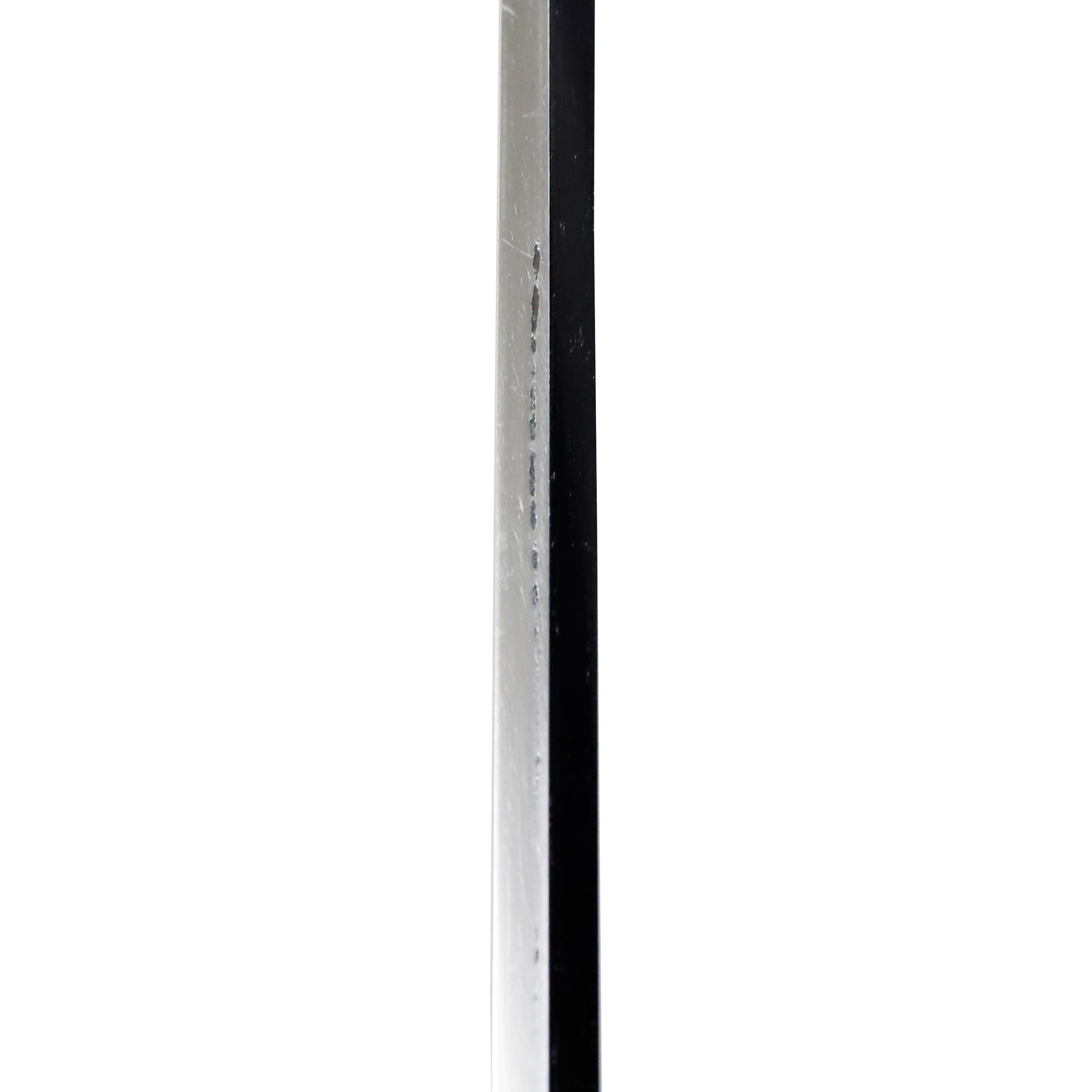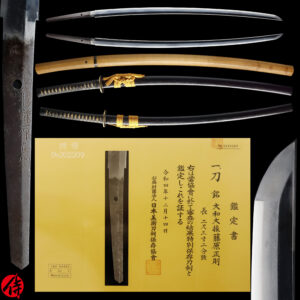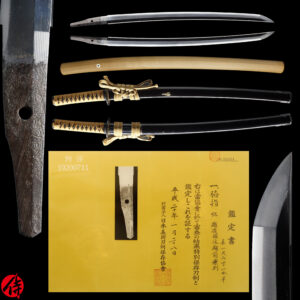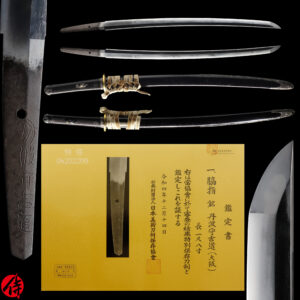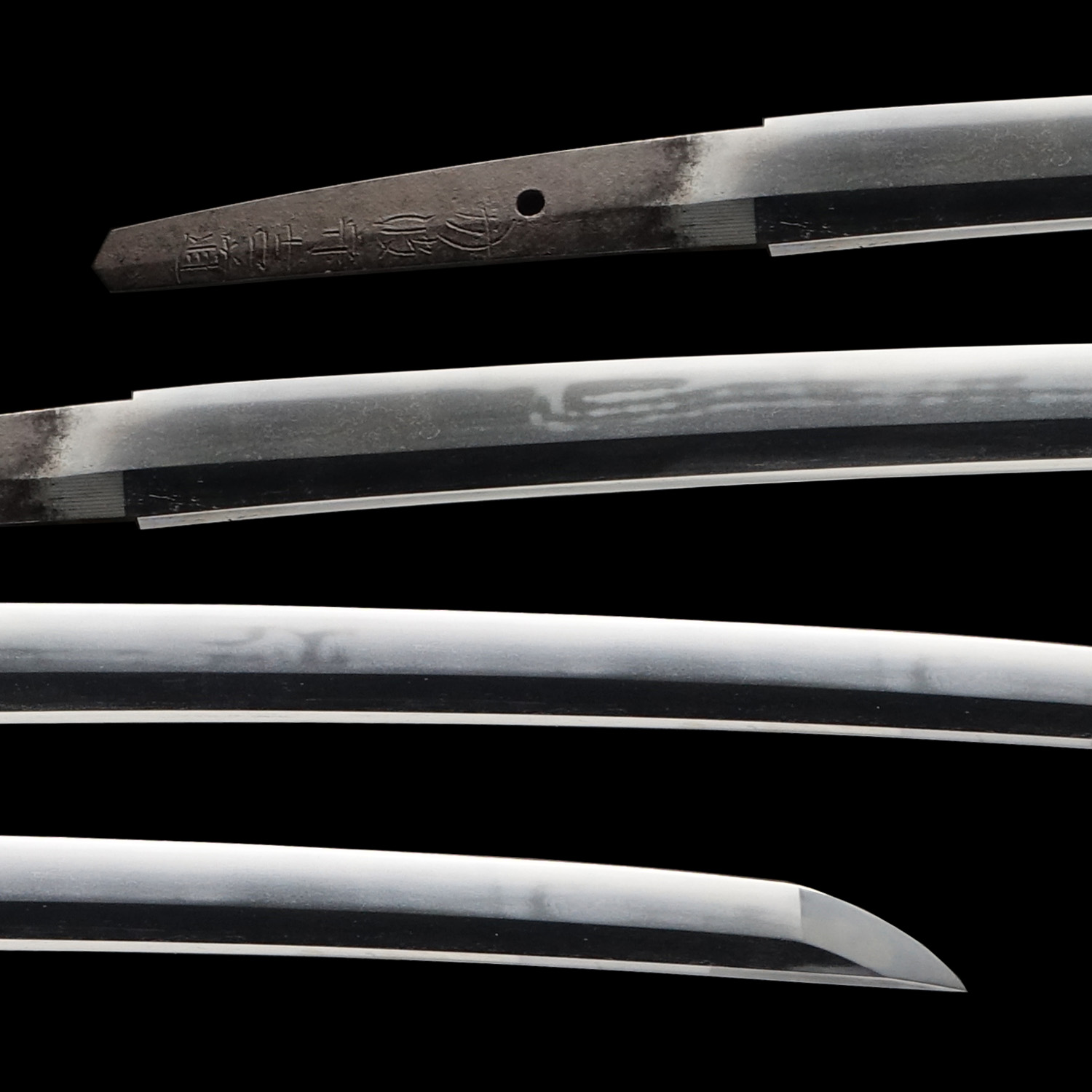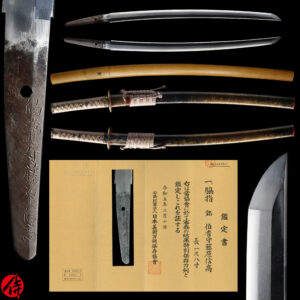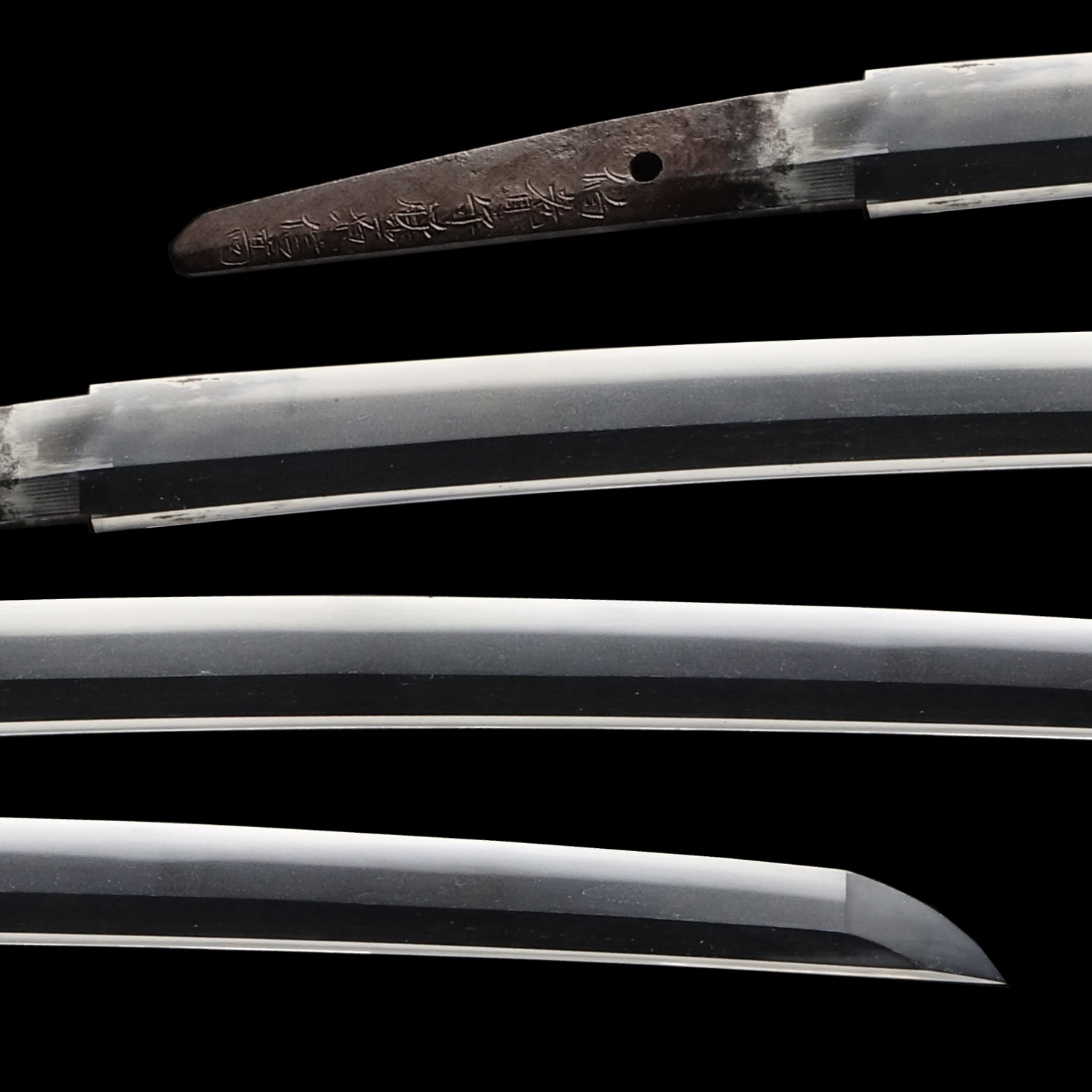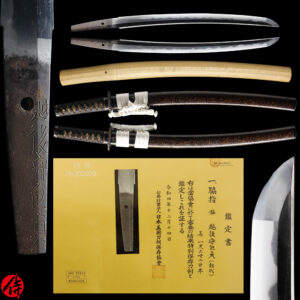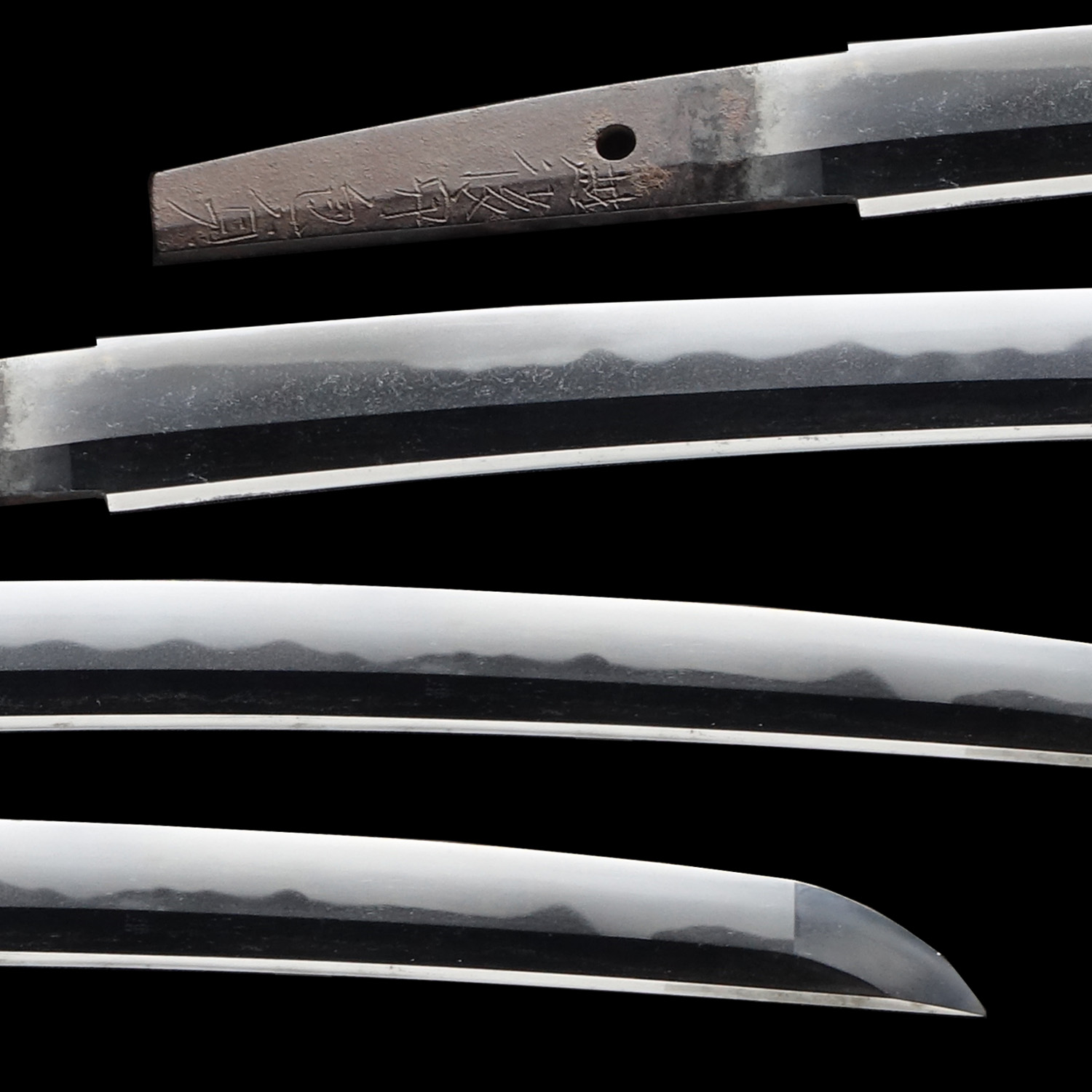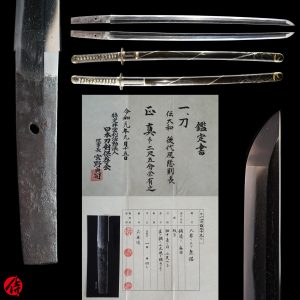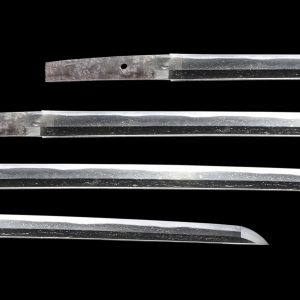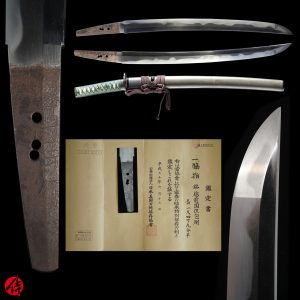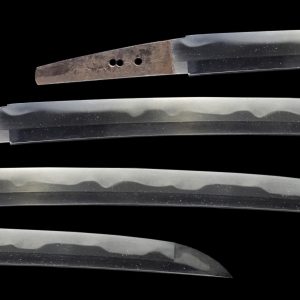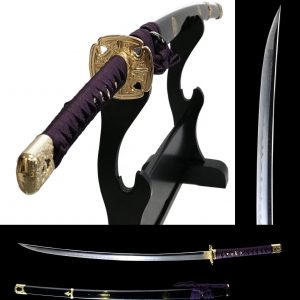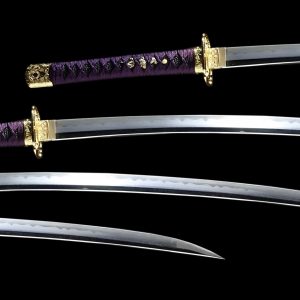Antique Japanese Sword Wakizashi Signed by Sukesada with NBTHK Tokubestsu Hozon Certificate
【Description】
Summary
This blade was signed by Bizen Koku Osafune Jyu Sukesada (備前国長船住祐定) in Feb, the 5th year of the Kyoho era (1720) in Bizen province (today’s Okayama prefecture). He is also known as Yamato Daijo Fujiwara Sukesada (大和大掾祐定). His father was Kozuke Daijo Sukesada. This Sukesada is called the 7th-gen Yosouzaemon no jyo Sukesada, one of the most famous prominent figures in Bizen province during the early Edo period.
He belonged to Bizen Osafune school located in today’s Okayama prefecture.
The swordsmiths in Bizen produced many swords during the Muromachi period, as it was in the middle of the Sengoku period(Warring State period). The demand for weapons increased among strong feudal lords. However, The sword-forging tradition of Bizen province almost disappeared because of the disastrous flood of the Yoshii River (1591), which was close to Osafune school. Even after everything was destroyed, there were few remaining swordsmiths. One of them was a group of swordsmiths who signed Sukesada. The main member of the school was Yokoyama Fujishiro Sukesada, the fourth head of Sukesada School. And one of his children was Shichibei no Jyo Sukesada (七兵衛尉祐定), grandfather of Ueno Daijo Fujiwara Sukesada. After the disaster, they became one of the pioneers that revitalized the sword-forging business in Bizen province.
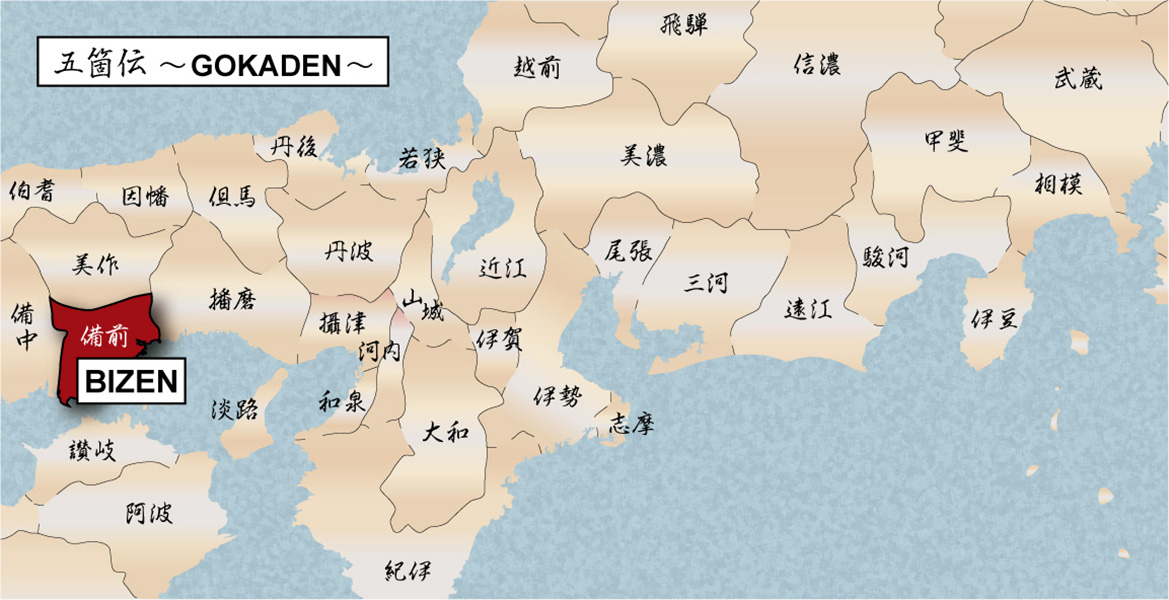
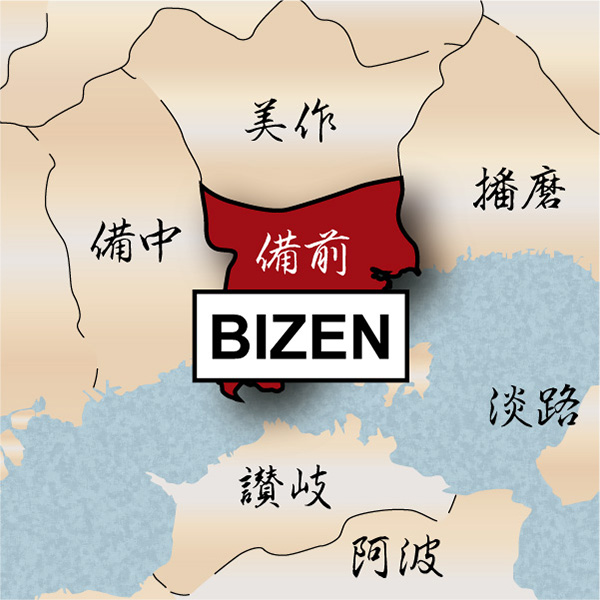
This History of Bizen Osafune School
It is said that Osafune school was founded by Mitsutada (光忠), who was active during the mid-Kamakura period. Bizen Osafune school was the biggest one of all other schools in Bizen province, and they received many orders from feudal lords or renowned Samurai. They were called Osafunemono and were beloved by Samurai warriors.
Among the swordsmiths who belonged to this school, Nagamitsu, Sanenaga, and Kagemitsu are known as Osafune Sansaku, the three renowned Osafune swordsmiths. There are also four other prominent swordsmiths who were from Bizen Osafune school. They are called Osafune Shiten-no, the four masters of Osafune school. Their names are Nagamitsu, Kanemitsu, Nagayoshi, and Motoshige.
BIZEN is located near the Chugoku Mountains, where iron sands, one of the essential materials for making Japanese swords, were abundant. Furthermore, BIZEN swordsmiths had close access to the Yoshi River, where they could find water and charcoal. This geological location contributed to the swordsmiths forging high-quality refined blades. We presume BIZEN was quite active in sword-forging from ancient times. It is said that BIZEN DEN was created by groups of swordsmiths there during the late Heian era (Late 12th century). These ancient swordsmiths in Bizen province are called Ko-Bizen (Old Bizen) swordsmiths. By inheriting the sword forging techniques from Ko-Bizen swordsmiths, the Bizen Osafune school flourished from the mid-Kamakura period.
This blade is appraised as a Tokubetsu Hozon Token(特別保存刀剣) issued by NBTHK(Nihon Bijutsu Touken Hozon Kyokai:日本美術刀剣保存協会). This authentication paper was only given to authentic Japanese swords, especially well preserved and high quality with artistic value.
*Please keep in mind that there is visible Kitae Kizu on the Mune (backbone of the blade). If you like to see the detailed condition, please check one of the uploaded photos. above.
【Blade】
Cutting Edge Length(Nagasa):45.4 cm (17.9 inches)
Curvature(Sori):2.0 cm (0.79 inches)

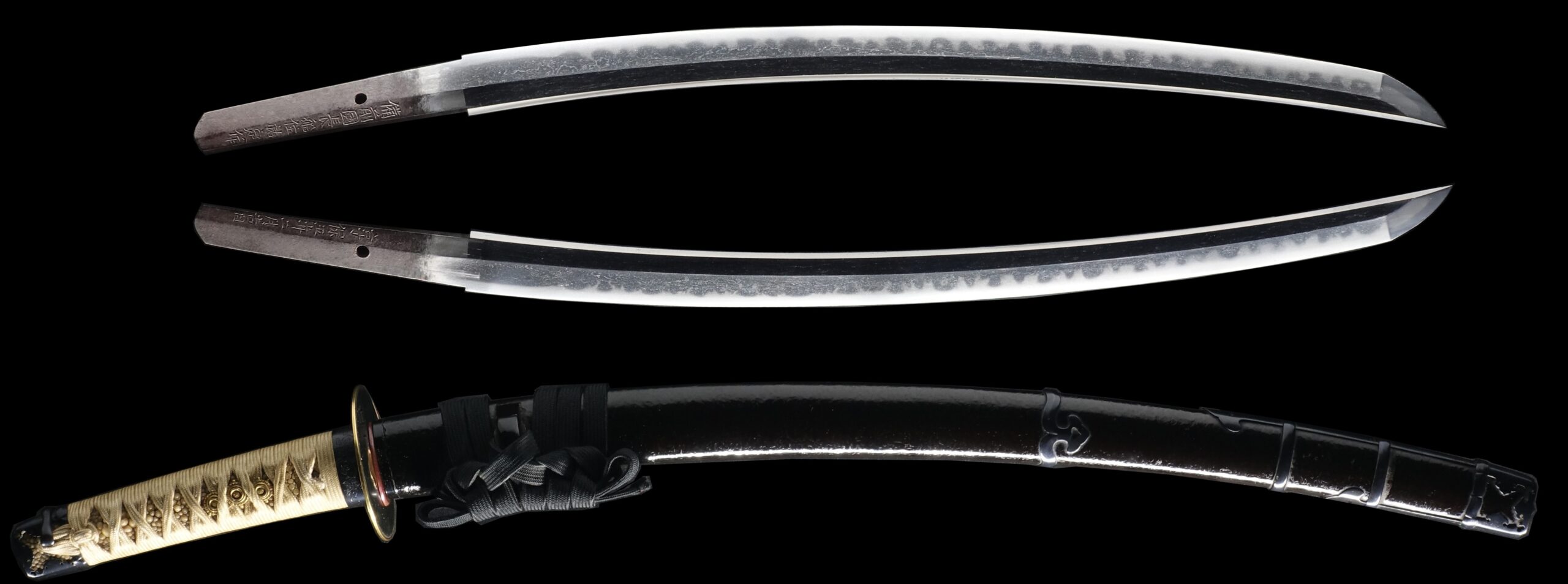
Hamon:
The crystalline structure which forms along the cutting edge of a blade as a result of the hardening process
Jimon(Jihada):
visible steel surface pattern created by folding and hammering during forging process
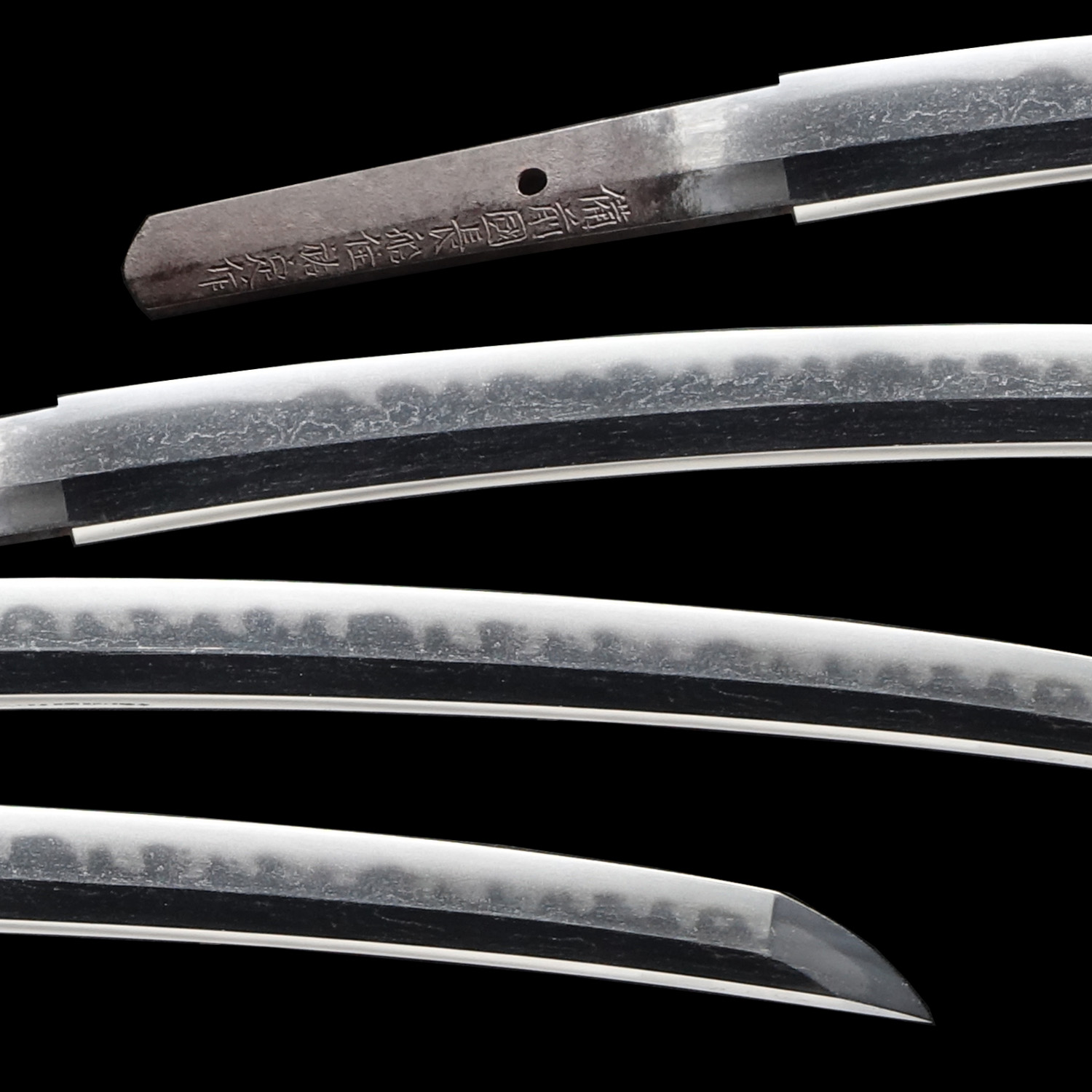
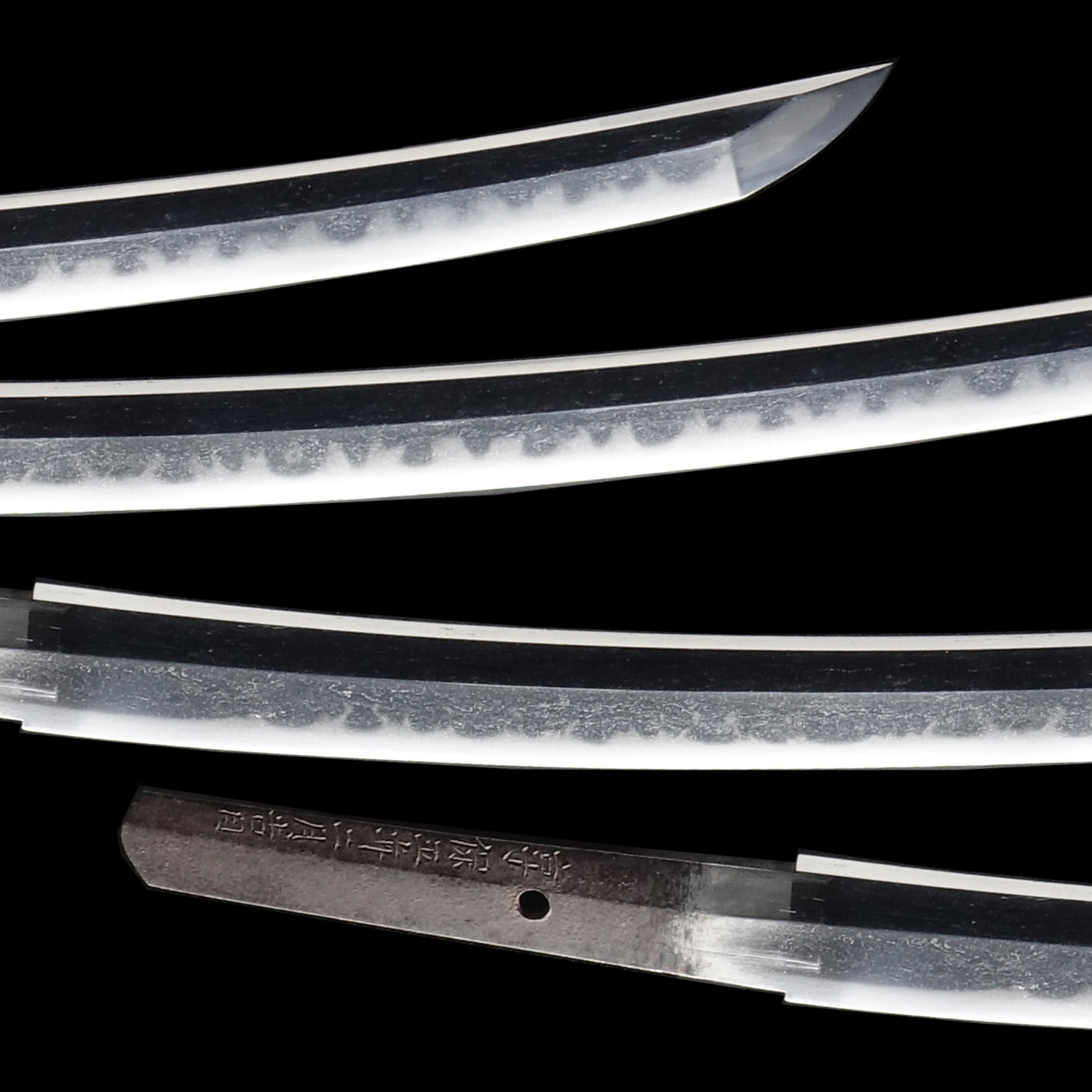
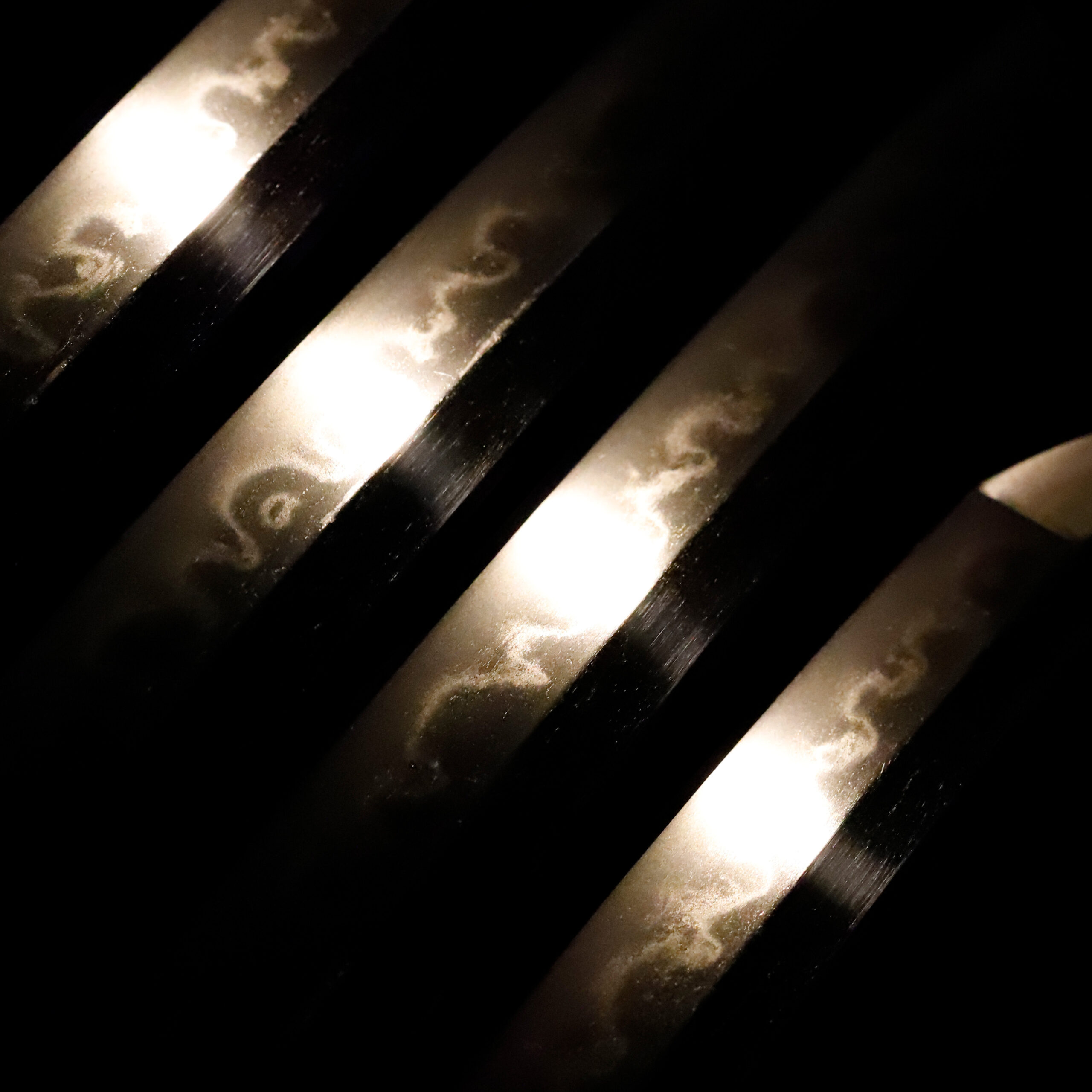

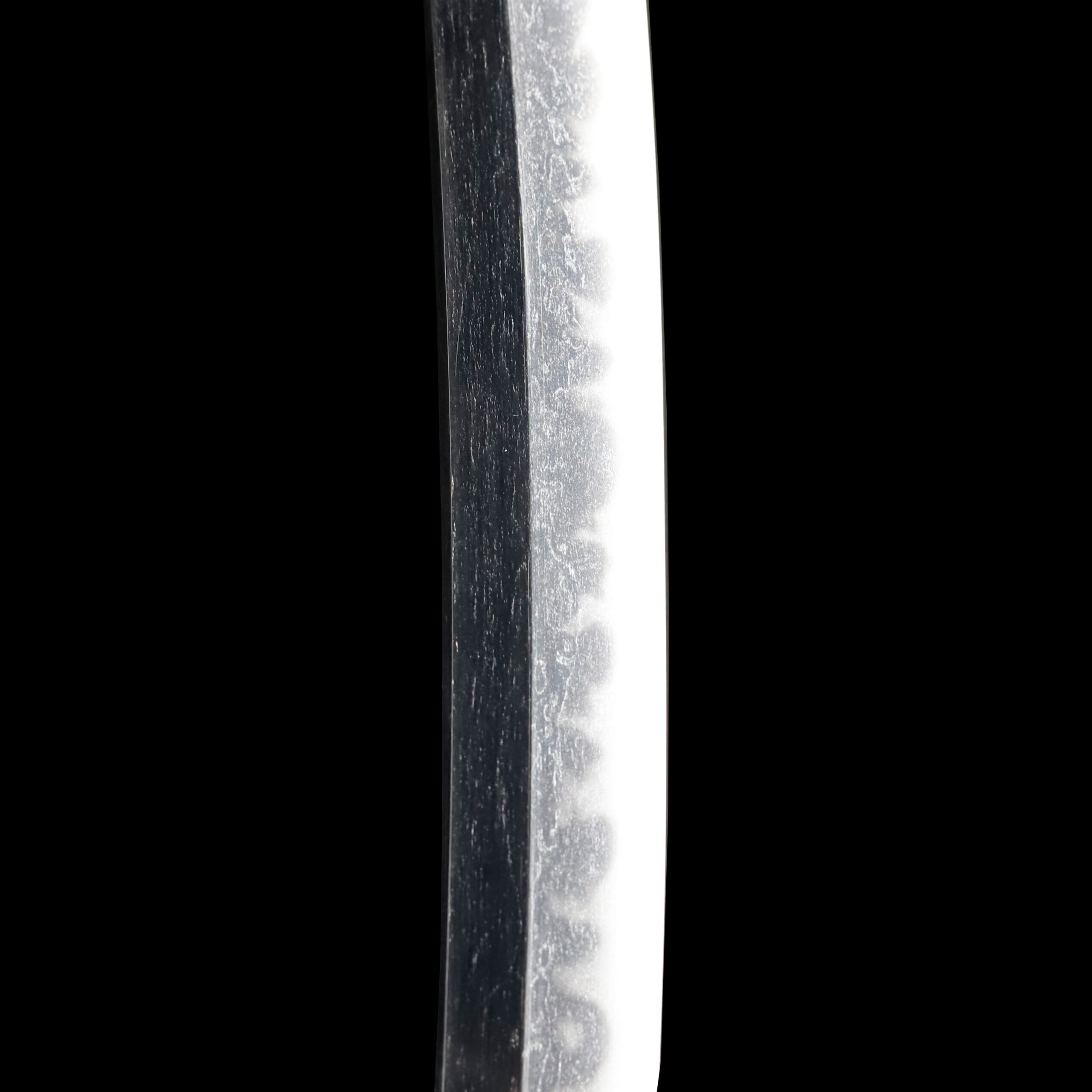
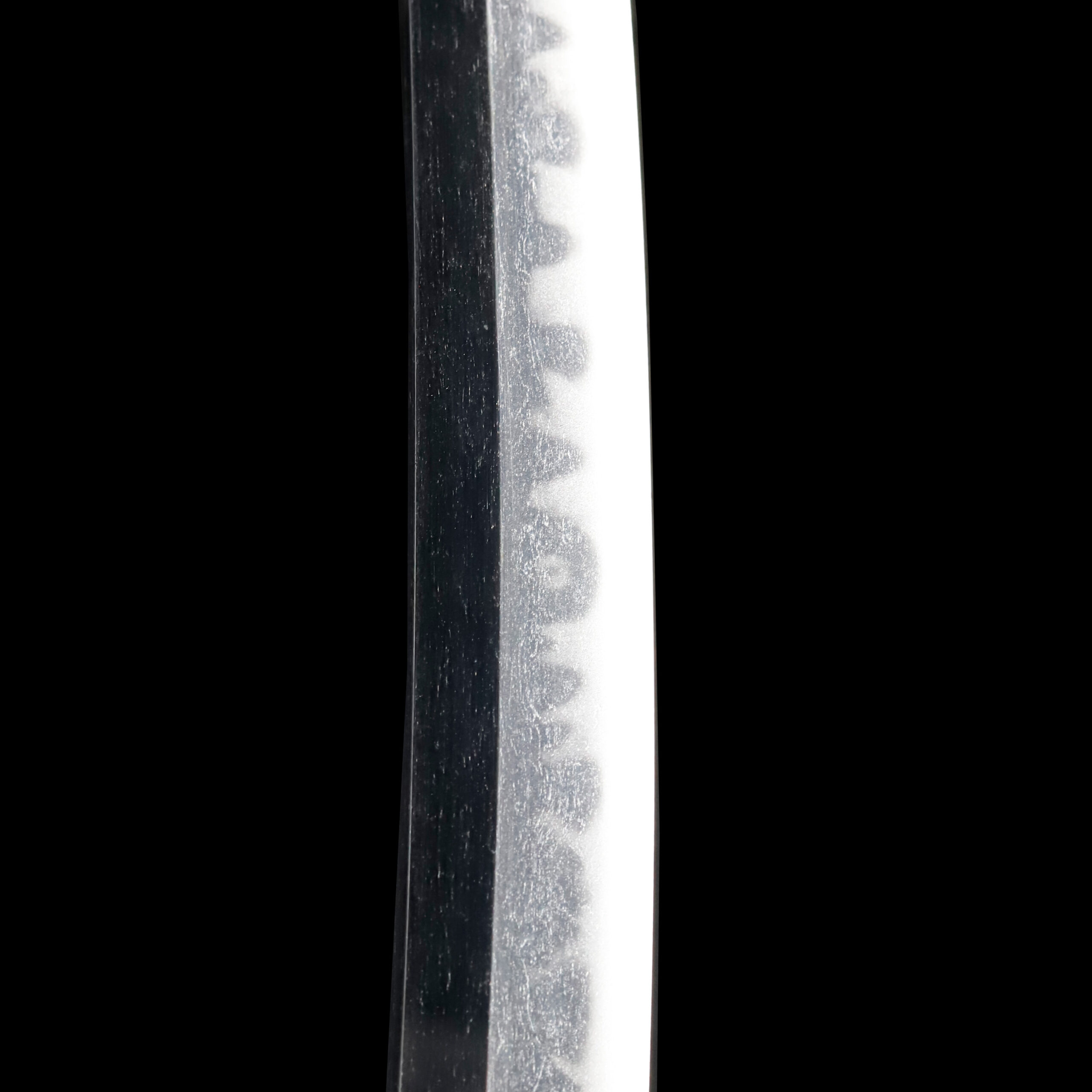
Nakago:Nakago is the tang of the Japanese sword.
Japanese swordsmiths left the black rust on the tang because it prevents red rust while the tang is in its handle. And the discoloration of the tang was created over time, and it is a great indicator for a Japanese sword specialist to estimate when the sword was forged.
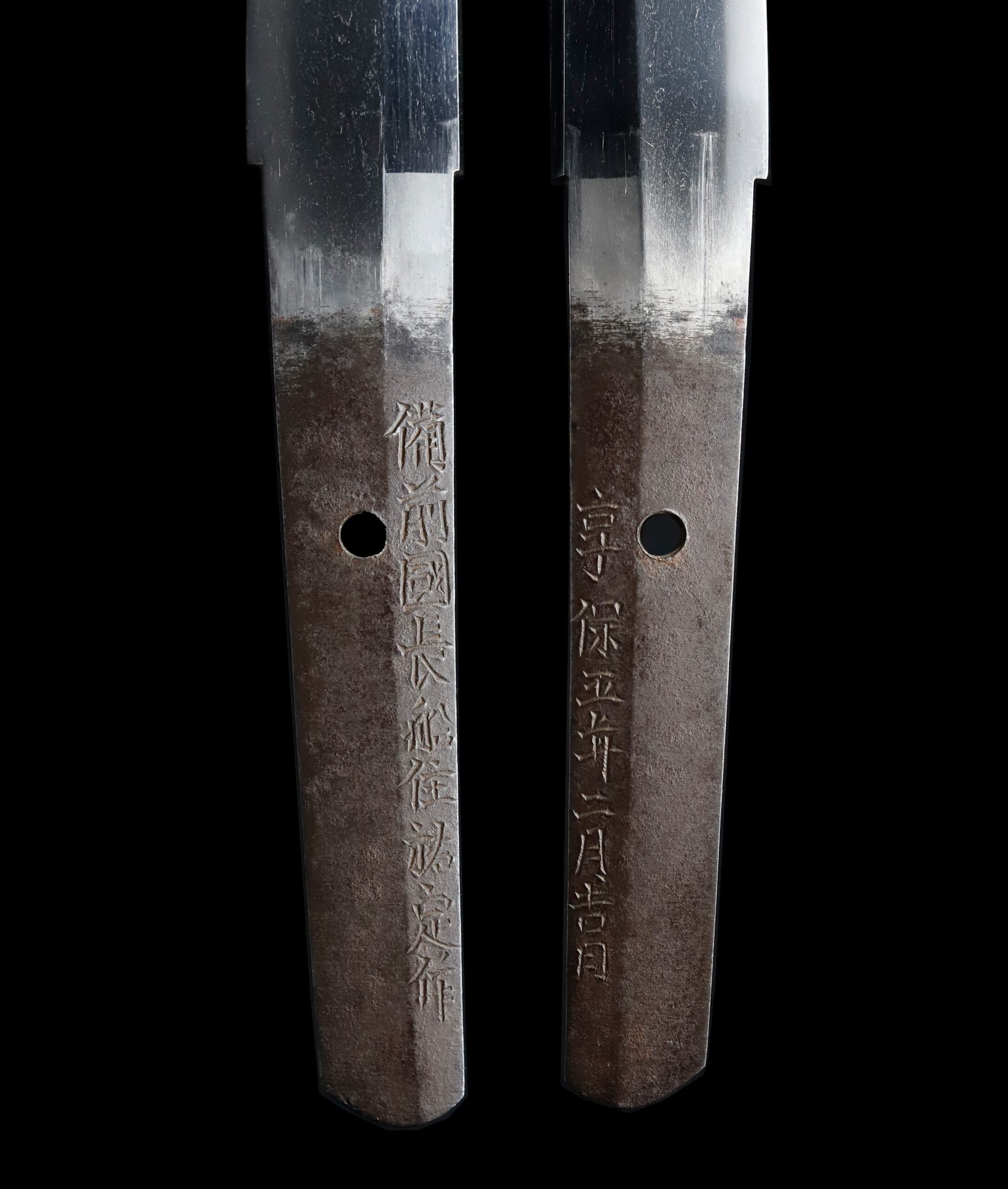
Koshirae: Koshirae is the mounting of the Japanese sword. There are several parts that consist of Koshirae such as Saya(Scabbard), Tsuka( Handle), Tsuba(Handguard).
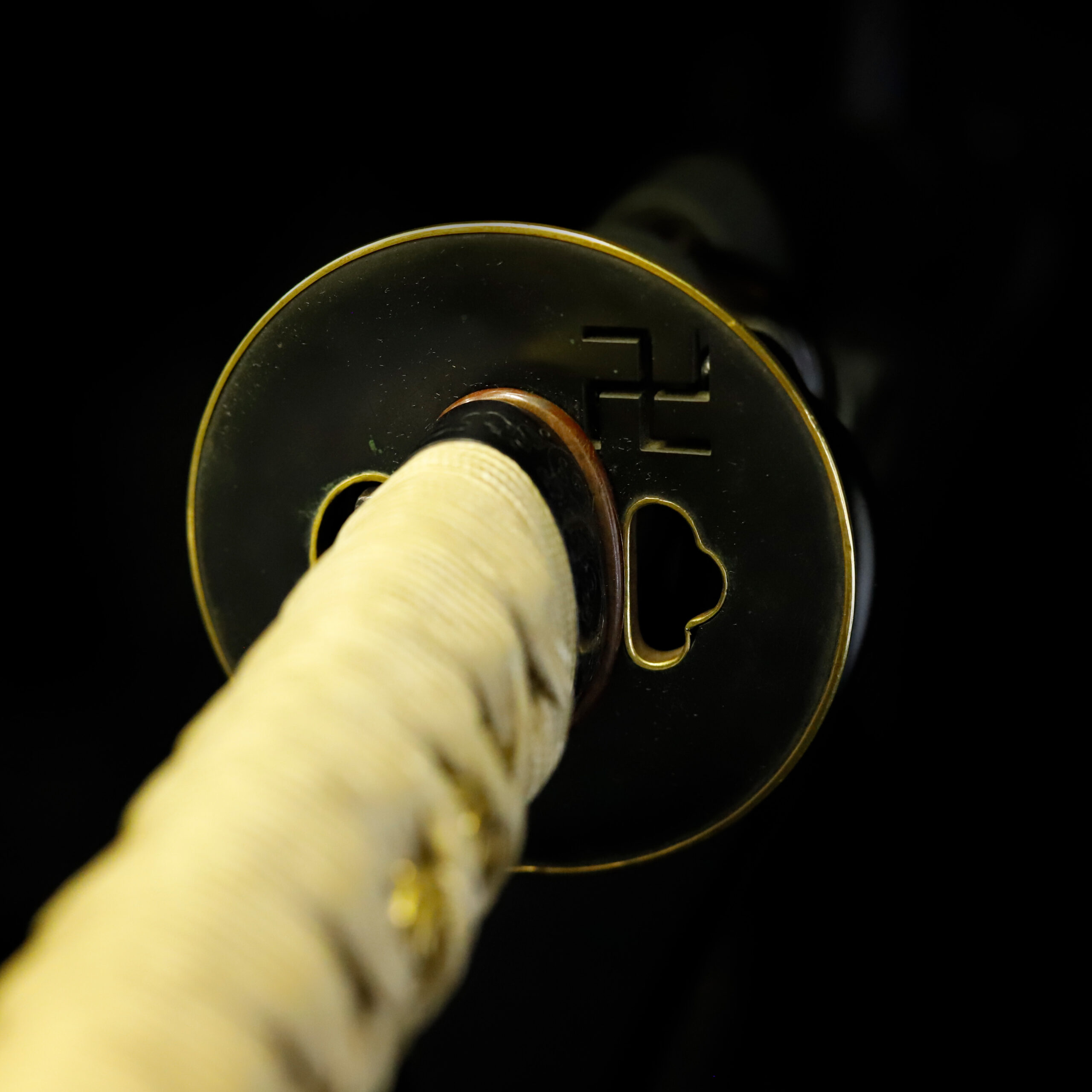
Fuchi-Kashira:A pair of matching sword fittings that cover the upper and bottom parts of its sword hilt.
The Kabutogane (冑金/兜金) is a metal fitting that is attached to the end of a handle. And a Sarute/Sarude (猿手) is attached to this Kabutogane. The user of a sword passed the Udenukio (腕貫緒, a cord wrapped around the wrist to prevent a sword from falling out of the hand, mainly used when riding a horse) through this ring. In addition, the Fuchi Kanamono (縁金物) is also a metal fitting attached to the handle, but on the opposite side of Kabutogane.
A combination of flowers and vines is engraved on this sword mounting. The shape of these flowers suggests that they are probably the Tessen (鉄扇, clematis) flowers. This flower’s petals spread out like a windmill and have stiff vines. There is a design that is called the Tessen Karakusa Mon (鉄線唐草文) that emphasizes vines. According to a theory, the Japanese name for this flower, Tessen, was derived from the fact that the hard vines remind us of iron wires (鉄線 means iron wire in the Japanese dictionary sense). This flower was appreciated as a flower to decorate tea parties, and people favored its graceful appearance. There are also various Tessen flower-designed family crests. Based on these facts, it is understandable that it was incorporated into sword mountings, as seen in this work.
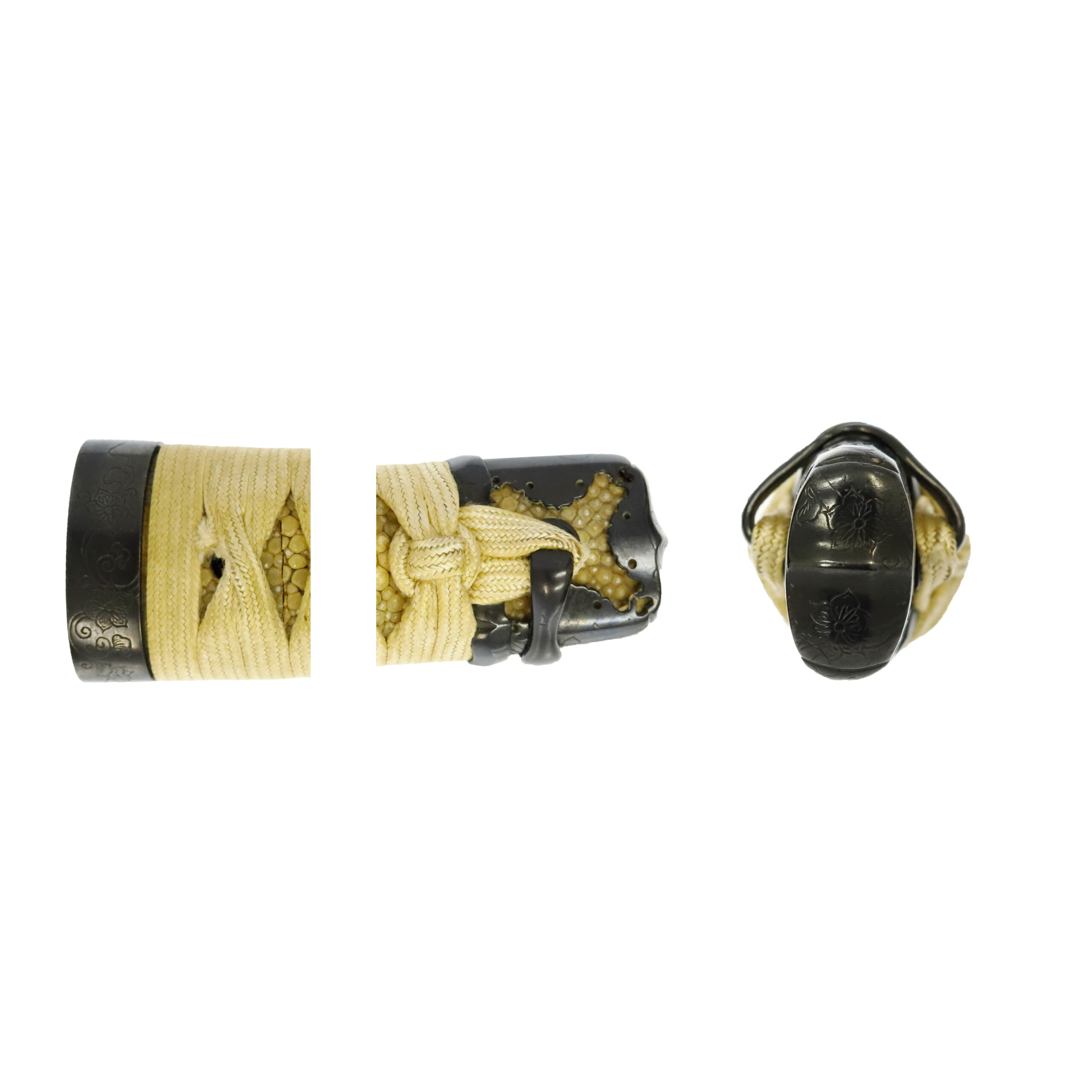
Tsuka and Menuki:Tsuka is the handle of the Japanese sword and Menuki is its decoration.
We estimate this Menuki’s motif is a combination of the Suisha (水車, waterwheel). Golden paint is applied to each Menuki, and this shiny coloring remains relatively in good condition. The Suisha Mon (水車紋) is a wheel-shaped pattern in which several ladles are attached to the ring. The waterwheel was developed as a familiar tool for daily life and was often used as a design for the Kosodes (小袖, a kind of traditional Japanese costume) in the Edo period. The Tsuchi (槌, hammer), which is similar to the Hishaku (柄杓, ladle), began to be drawn in the early Edo period. The waterwheel on which the hammers are drawn is called the Tsuchi Guruma (槌車). Since the hammer is a tool for hitting stakes, and “hit” is said Utsu (打つ) in Japanese, it is likened to the figure of Samurai hitting an enemy. Hitting the enemy is expressed as Teki-Wo Utsu (敵を討つ) in Japanese.
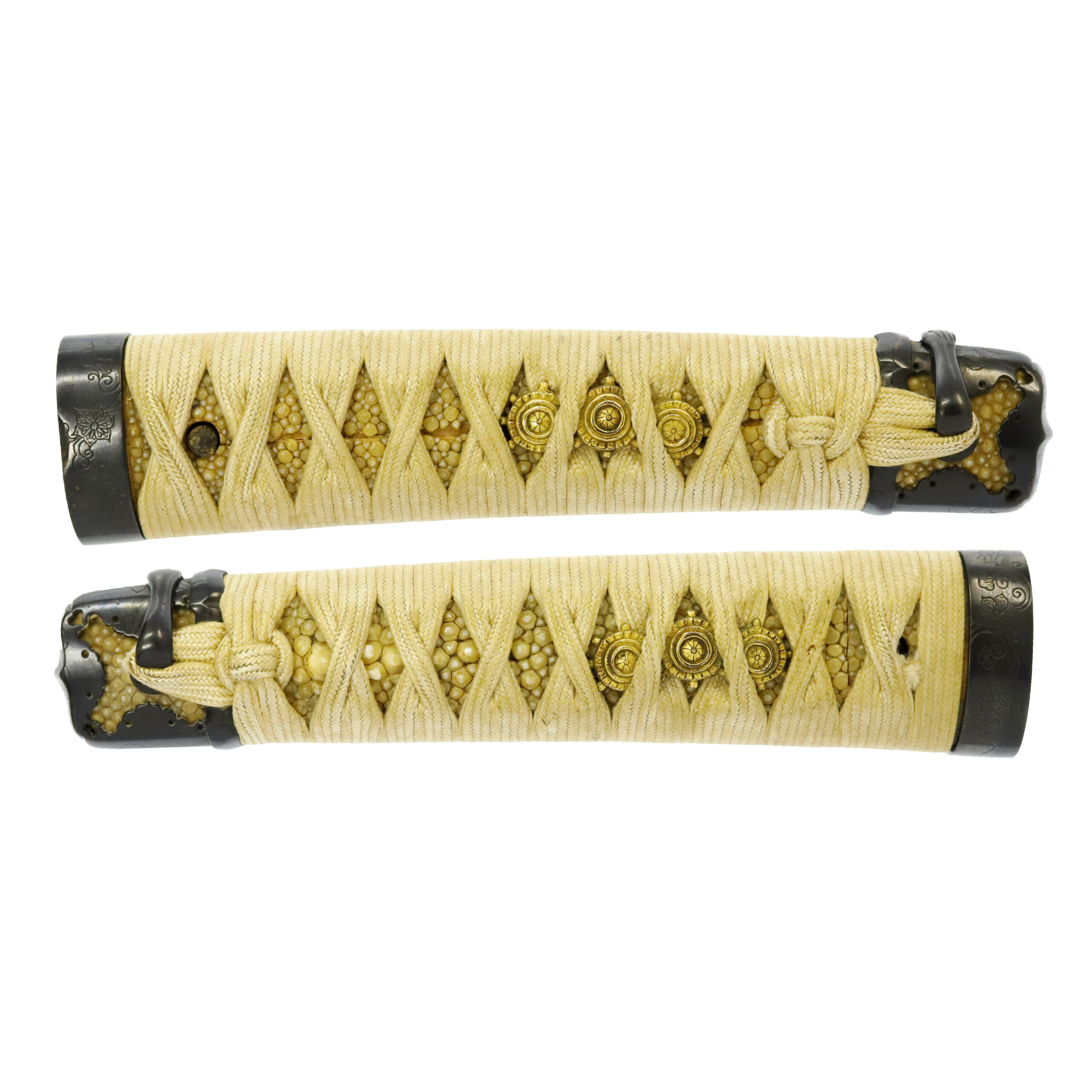
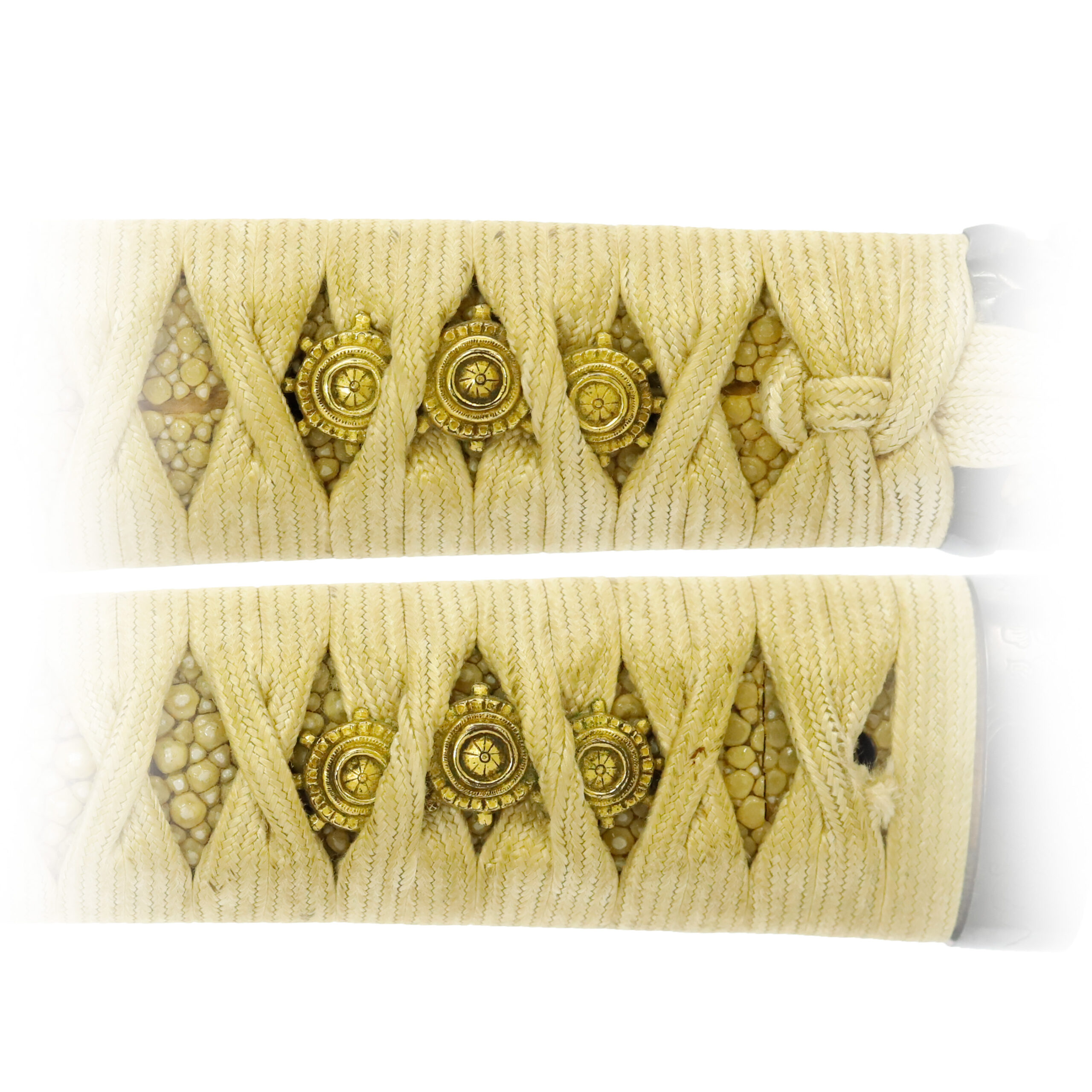
Tsuba and Habaki:Tsuba is the handguard for the Japanese Sword and Habaki is the equipment to make the blade not touch its scabbard inside. It prevents the blade from getting rusty and chipped.
The edges of this Tsuba are framed with a thin golden metal. This process adds decorativeness to this work and also increases sturdiness. About the design, you would find a geometaric patten is engraved on this Tsuba. This mark is called the Manji Mon (卍文). The Manji motif itself is one of the patterns brought to Japan with the introduction of Buddhism. A theory says it is initially related to Hinduism. This design represents luck and has been used as an emblem of temples.
Here is the story about the Samurai who used a kind of Manji family crest called the Hachisuka-Manji Mon (蜂須賀卍文) or the Maru-ni Manji Mon (丸に卍文). Hachisuka Koroku (蜂須賀 小六, his real name is Masakatsu) was one of Toyotomi Hideyoshi’s oldest vassals. The Hachisuka family was a feudal lord based in the Hachisuka District in Owari Province (尾張, today’s western part of Aichi prefecture). Koroku also temporally served under famous Samurai such as Saito Dozan (斉藤道三, 1494-1556)or Oda Nobutaka (織田信長, 1534-1582). In any case, Koroku decided on Hideyoshi as the lord of his life. And he remained loyal to Hideyoshi until his death. Many other Samurai families used the Manji pattern for their family crests; it shows how popular this design was among Samurai warriors.
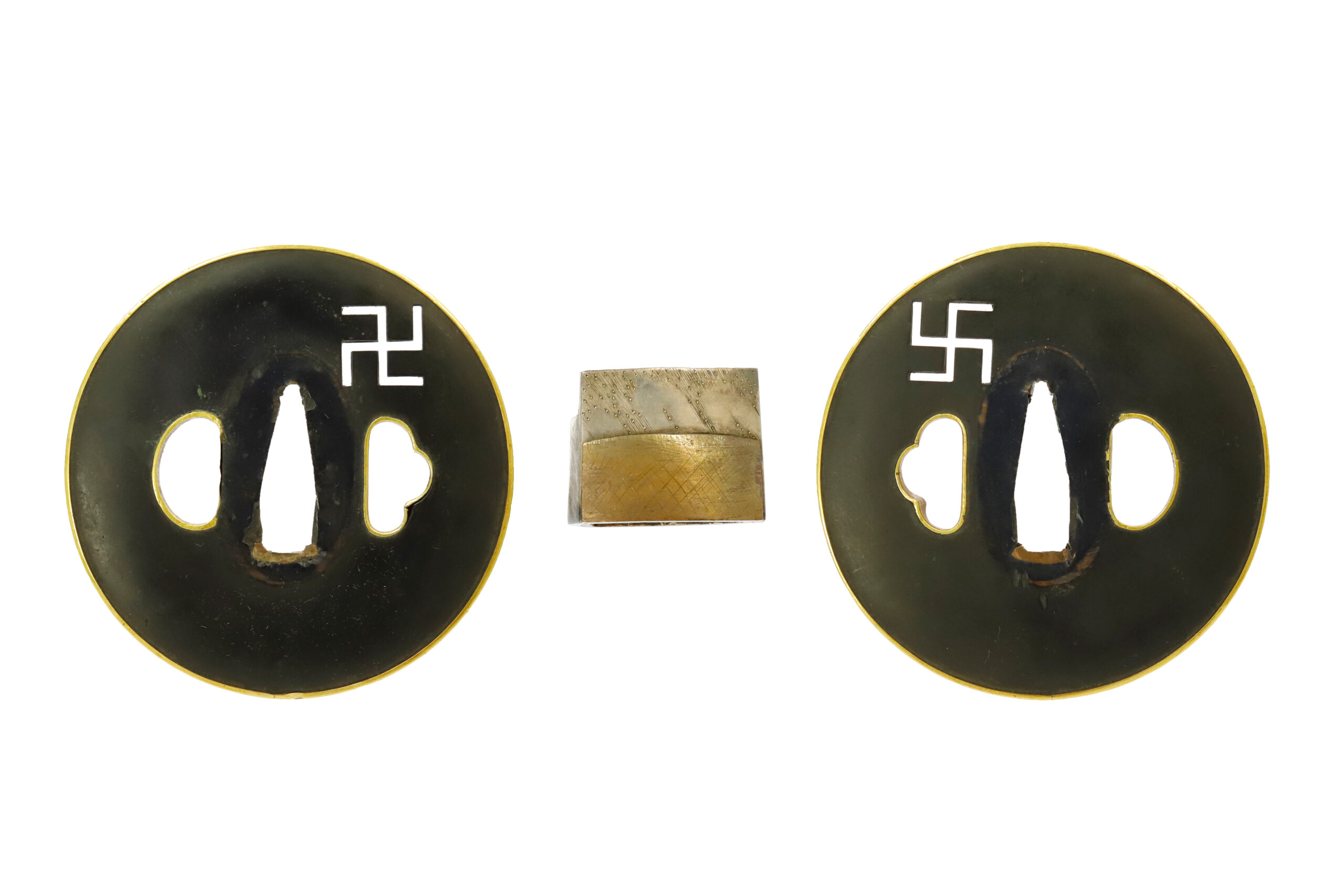
Kozuka:Kozuka is a small knife stored in Kozuka Hitsu(groove of the sheath of the Japanese sword).
A Kogatana (小刀, small knife) is stored in the Kozuka. On the Kozuka, you would find the figure of a turtle-like animal. It is probably a turtle, but the shape of its head and other features are slightly different from commonly seen turtles. We estimate it is Genbu (玄武), who is a god in the continent and deification of the stars of the north. Genbu is a member of Shijin (四神, four gods) with Seiryu (青龍), Byakko (白虎), and Suzaku (朱雀). Each of these spiritual beasts protects the four directions: north, east, west, and south. Genbu has long been said to be a god that has the power to ward off evil spirits and epidemics. In addition, since this spirit animal symbolizes the underworld (life) and water, which are the elements that are directly connected to human life, it is said that among the folk, Genbu was the most popular of the four gods, and folk religion was popular.
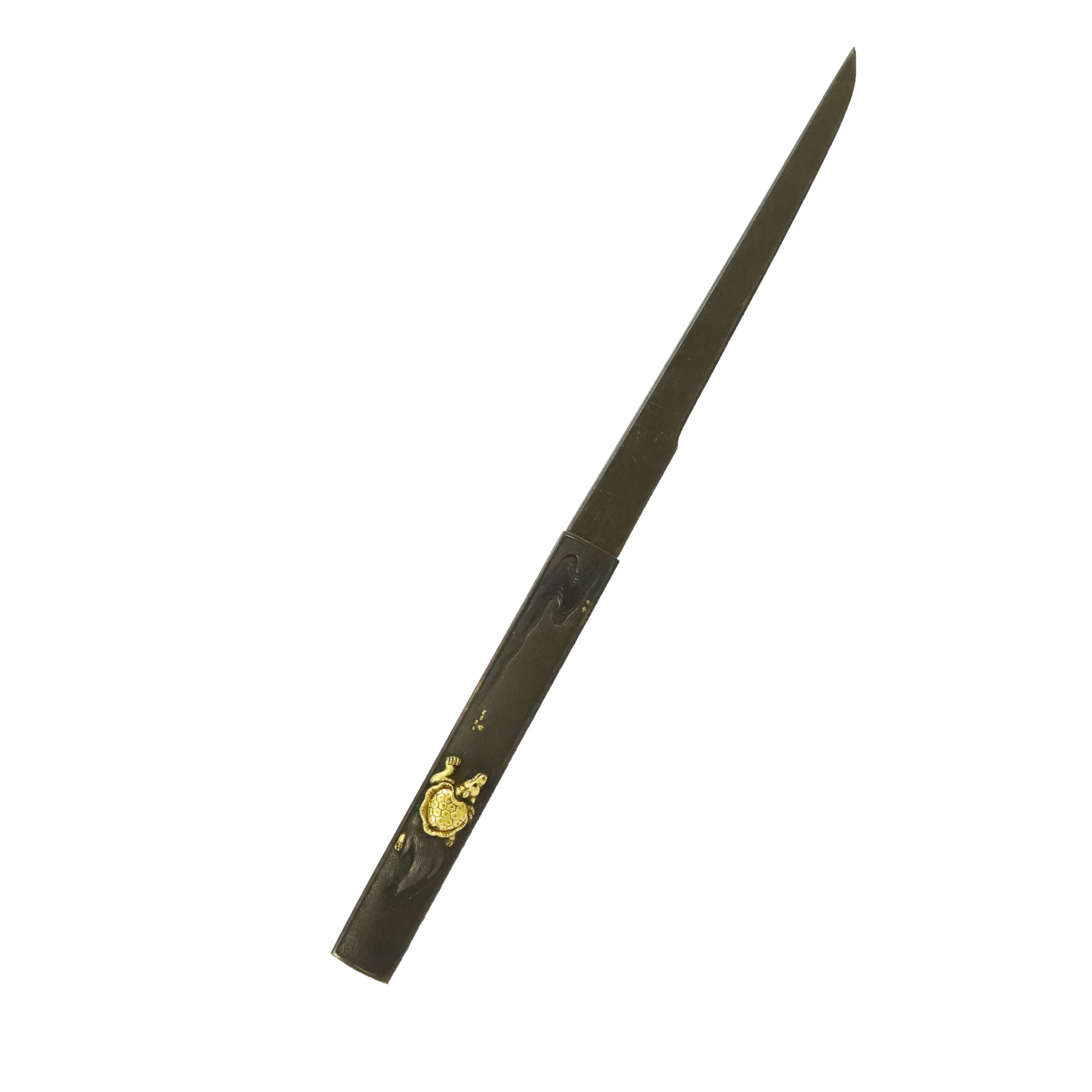
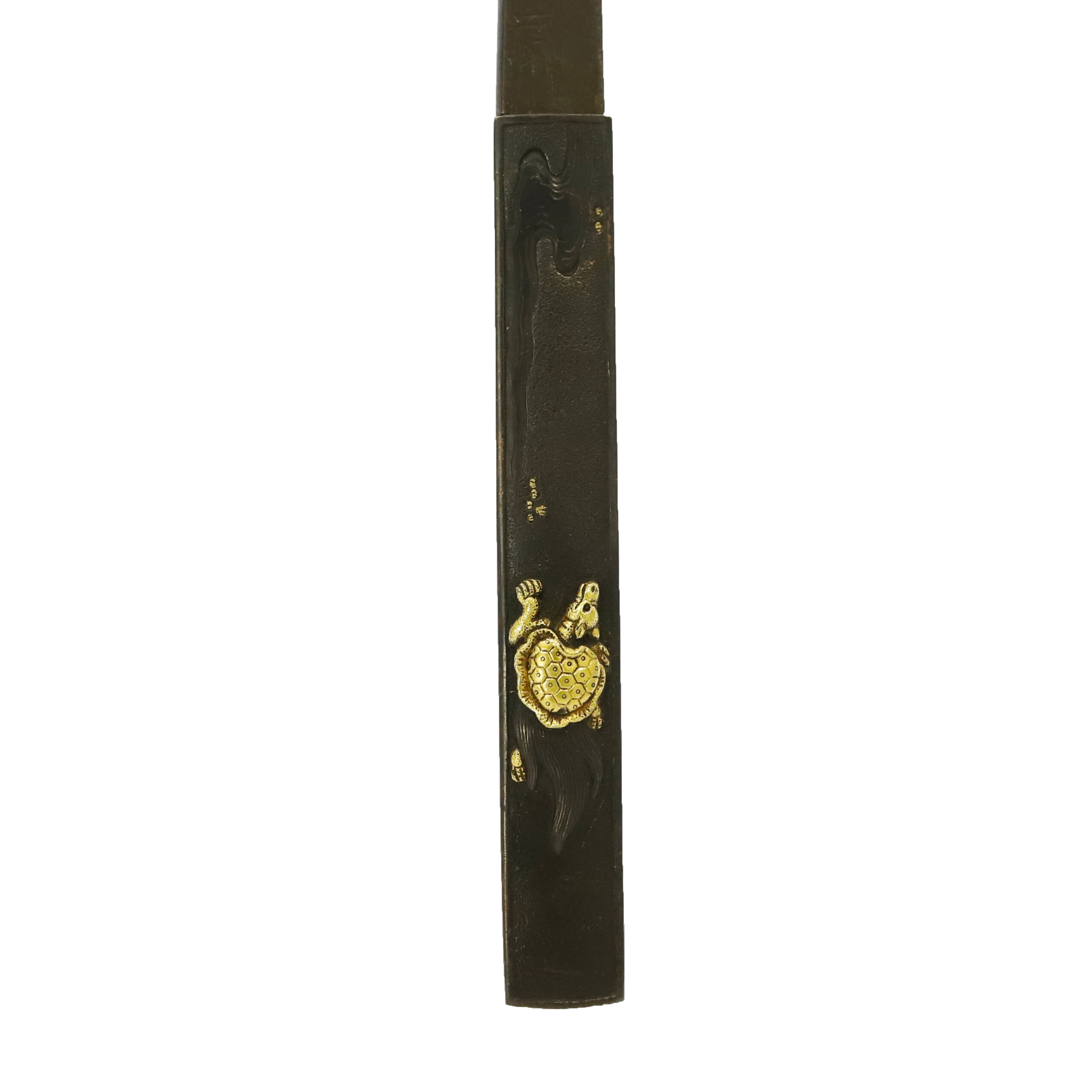
Saya: Saya is the scabbard for the Japanese sword.
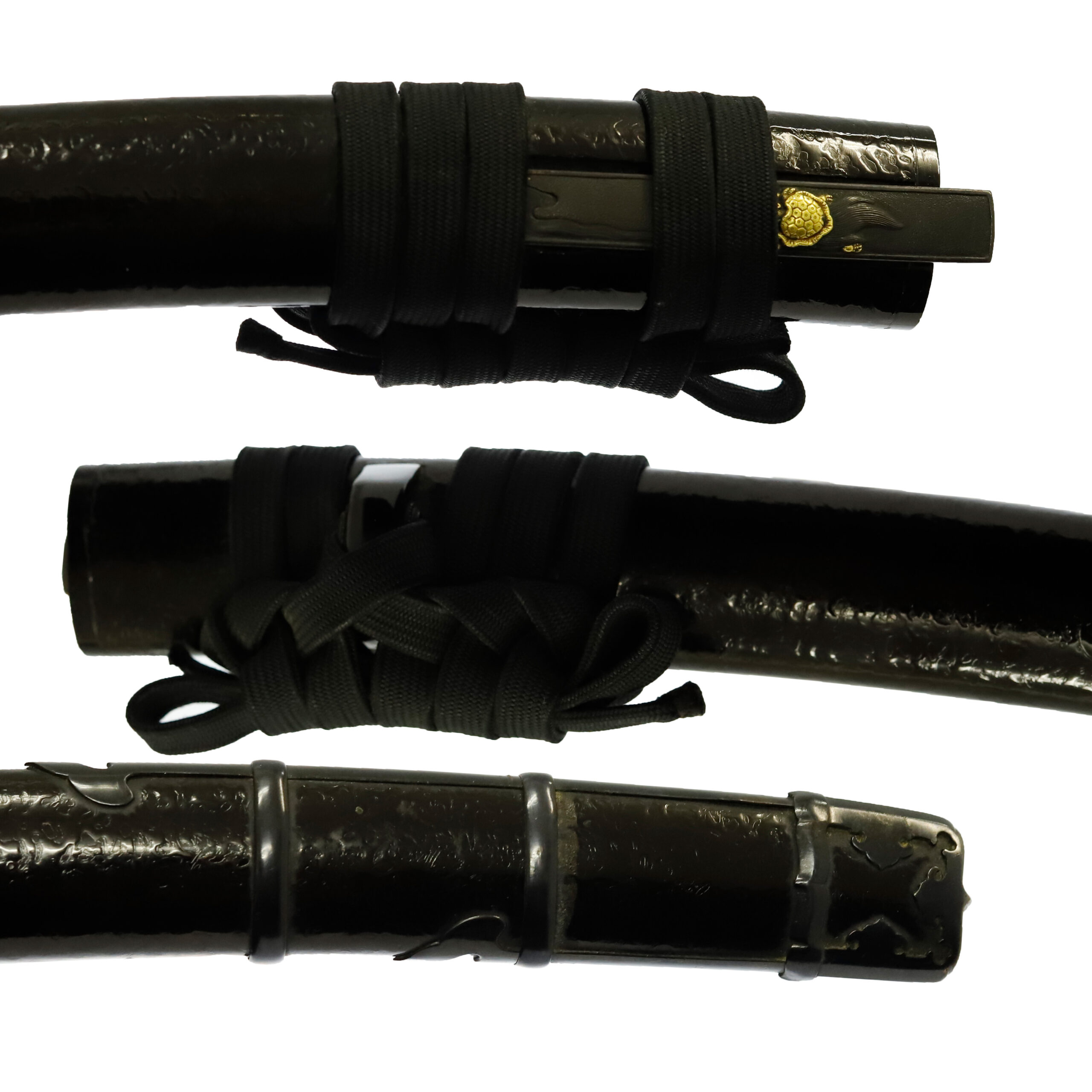
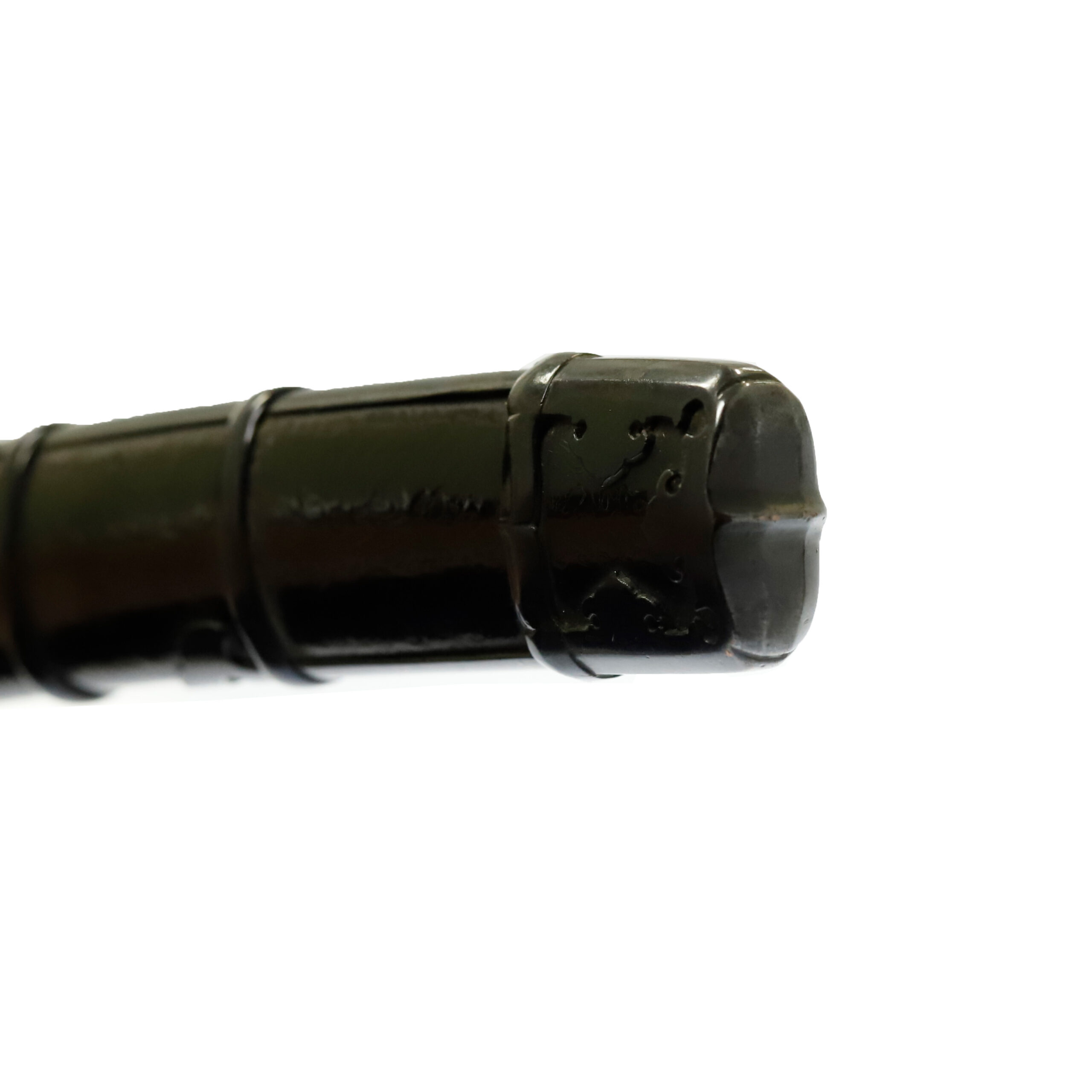
Authentication Paper:NBTHK Tokubetsu Hozon Certificate for the blade (No. 1006349)
NBTHK, also known as Nihon Bijutsu Touken Hozon Kyokai (the Society for the Preservation of the Japan Art Sword), is one of the oldest Japanese sword appraising organizations in modern-day Japan. They authenticated the blade on August 26th in the 28th year of Heisei (2016). They appraised it as Tokubetsu Hozon Touken, the blade especially worth preserving for Japanese society. The purchaser will receive this original certificate as well. We can also translate what is written into English and make a PDF file for your record if you request.
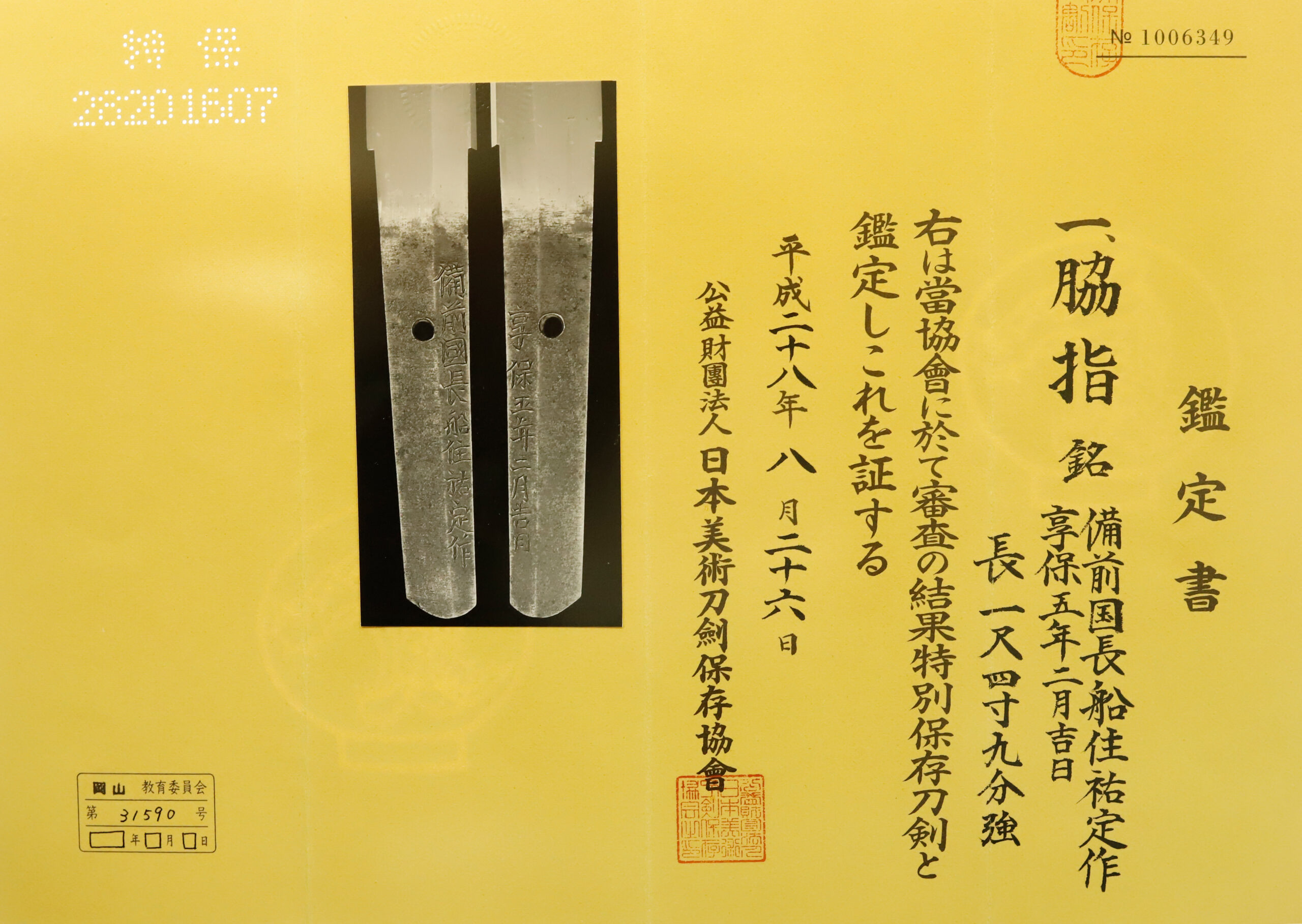
Registration Number : Okayama 31590
The Board of Education in Okayama prefecture issued a registration paper for this sword. It is called Jyu Token Rui Torokusho(銃刀剣類登録証). Bunkacho(The Agency for Cultural Affairs) acknowledges a Japanese sword with this paper as a work of art.
The sword needs to be traditionally hand-forged and made of Tamahagane carbon steel to be registered in the system. With this paper, its owner in Japan can legally own an authentic Japanese sword. Based on this registration number, we will apply for its export permit.
This paper will need to be returned to the board of education when the sword is being shipped abroad, but you can receive a copy of it. An English translation of this registration paper is available on request.
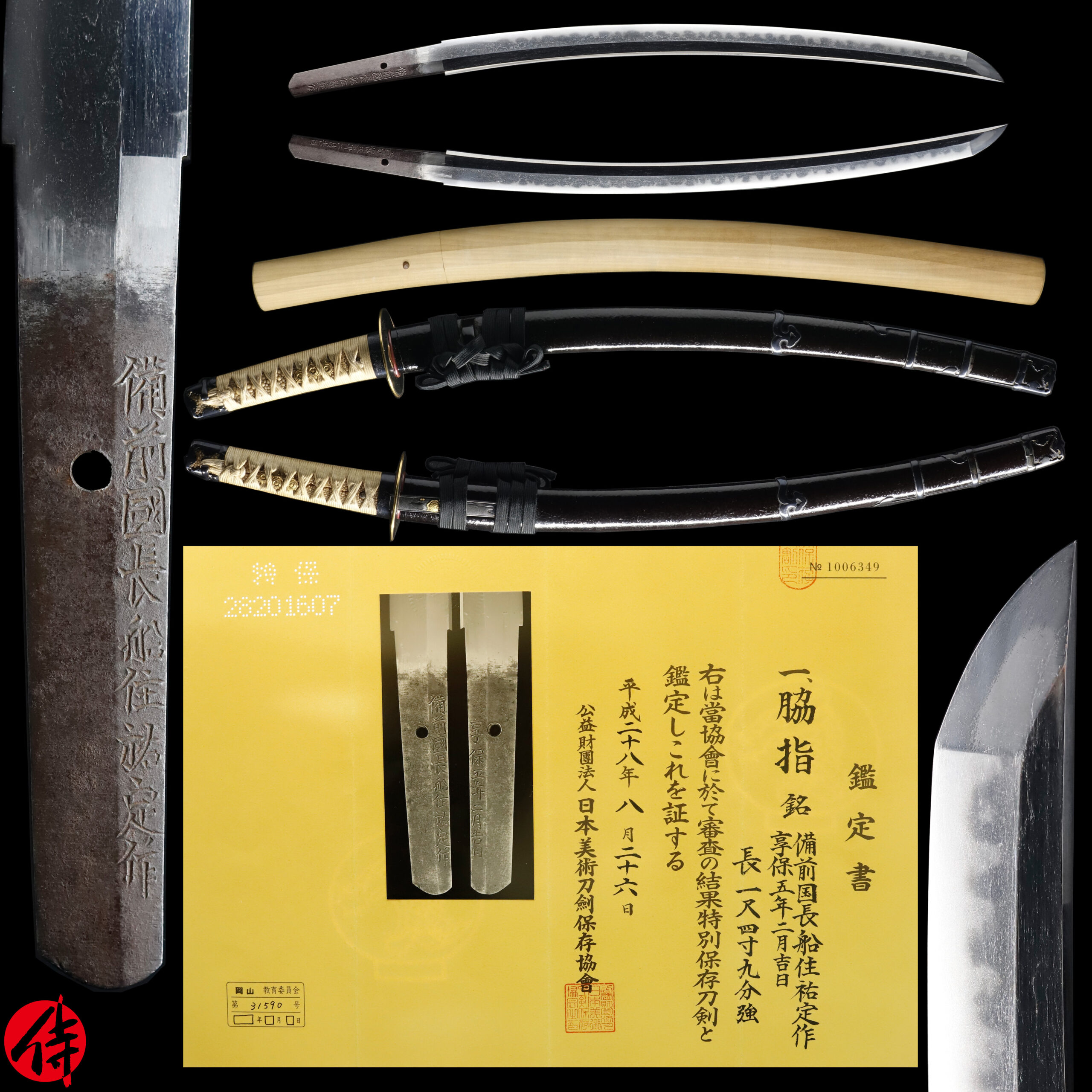
—————————————————————–
【About us】
Samurai Museum is located in Tokyo, Japan, exhibiting antique artifacts related to the Samurai history. Samurai Museum Shop is the place for those who are interested in Japanese culture and craftsmanship. We deal with antique Samurai swords/armor, traditional crafts made in Japan and so on.
【Japanese Sword& Export Process】
The Japanese swords we deal with are hand-forged edged swords made in Japan. It was made from the traditional carbon steel called TAMAHAGANE(玉鋼). Samurai Museum is familiar with the proper legal procedure for an antique/ authentic Japanese sword to be exported from Japan. We have sent more than 700 Japanese swords for the past few years (~2024) to amazing owners who appreciate its historical value.
Each Japanese sword is registered under the Agency for Cultural Affairs and the Board of Education in Japan. They issue a registration paper for each Japanese sword for its owner in Japan to legally possess it. The Japanese sword with its registration paper means it was traditionally hand-forged in Japan.
To legally export the sword from Japan to other countries, we will have to apply for its permit to the Agency for Cultural Affairs(Bunkacho) and return the original registration paper to the Board of Education. It normally takes around 2-4 weeks to receive this permit after submitting required documents. And we would like you to expect at least 1-1.5 months for your order to arrive at your given address after you ordered. For more detailed info, please click here.
It is allowed for residents in Japan to own authentic Japanese swords without a special license as long as they come with registration papers. Please feel free to contact us if you are a resident of Japan, whether temporarily or permanently. We will also assist you when you leave Japan and need to obtain the export permit.
【Payment Method】
We accept payment through Stripe (Credit card), PayPal, Apple Pay or ChromePay, all of which are secure payment methods. Also, you don’t need to make an account on Stripe for the checkout. If you prefer other payment method, please contact us. After confirming your payment, we will apply for an export permit. You may either pay in JPY, USD, AUD, CAD,EUR CHF or GBP. The price is set in Japanese Yen. Prices in other currencies are automatically calculated based on the latest exchange rate.

* If the amount is above 1 million JPY, Stripe or wire transfer will be the only options for payment.
【Shipping】
We have shipped authentic Japanese swords to the USA, UK, Canada, Mexico, Germany, France, Hong Kong and Australia. If you don’t live in these countries and like to order, please contact us first before making a purchase. We offer Free International Shipping as long as we can send antique Japanese swords by EMS.
We normally ship by EMS(Express Mail Service) provided by Japan Post. We will send you a tracking number for your order as soon as we hand it to the post office. We will put 100 % insurance on the shipping document without any extra charge. Based on the total amount, there might be a duty tax or other fee for you to pay, depending on the countries. We use package cushioning to protect the item and put it in a PVC pipe, which is one of the most secure packages because of its durability.
It will normally takes 5-14 days for the item to arrive at your given address after we dispatch it. Time of delivery is estimated as accurately as possible by the carrier but does not take into account any delays beyond our control such as by inclement weather, post office holiday seasons.
* If you live in Australia and like to purchase an authentic Japanese sword, please click here to know the detail.

【Review】
Here is one of the reviews we received from a customer who purchased an authentic Japanese sword from us. For more reviews, please click here.
“My experience overall with the whole process was wonderful. I had many questions about the history and process to purchase these treasures. All my questions were answered very timely and complete. The staff is very knowledgeable and very well versed if any questions do arise.”
【How to make sure the condition】
Please keep in mind that what you are going to purchase is an antique item. We uploaded high resolution photos for you to check its condition thoroughly. If you like to see more photos with different angles, please feel free to contact us. We will be happy to send them to you so that you can make informed decision. It is essential for us to know that you are happy with your choice of a sword. and we are prepared to use the best of our ability to serve you.
【How To Contact Us】
Please contact us through email, Facebook Messenger or Live Chat if you have any questions. You can find each icon on the right side of the website. Please click one of them to reach us. We will reply to you within 1-2 business days.
【The Art of Nihonto (Japanese Sword)】
Samurai’s history is a profound, eloquent legacy of ancient Japanese warriors in which millions of people worldwide are being fascinated. If you like to find out the art of Nihonto, please click here.
【A Guide to Japanese Sword Maintenance】
After acquiring an genuine Japanese sword, it is also important to know how to take good care of it. Here is the special video for you. Mr. Paul Martin, Japanese sword expert, shows you how to give proper maintenance to your sword. By mastering how to clean the Japanese sword, its aesthetic beauty will last forever.
When you purchase a Japanese sword from us, you can get a Free Japanese sword maintenance kit. It comes with four tools(Choji Oil, Uchiko Whetstone Powder, Peg remover, Oil Applicator). By watching the video instruction above , you can enjoy learning how to maintain your Japanese sword while appreciating it. If you have any difficulty assembling the sword or cleaning the blade, you can feel free to contact us.


MORE ANTIQUE JAPANESE SWORD FOR SALE
SWORDS WITHOUT CERTIFICATES FOR SALE
LEARN JAPANESE SWORD TERMINOLOGY
Thank you for reading all the information on the page. If you have any difficulty choosing the right Japanese sword for you, we will be more than happy to help you find the one that speaks to you the most. Please feel free to contact us.
